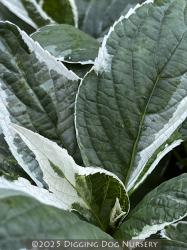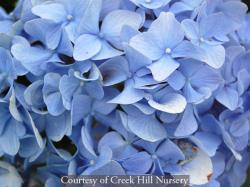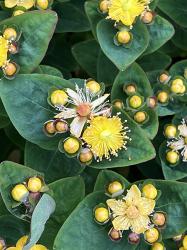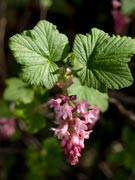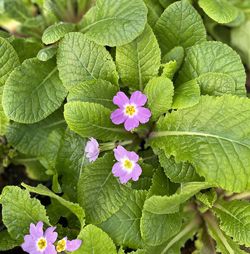Including Hydrangea, Lavandula, Syringa, Teucrium, & Viburnum
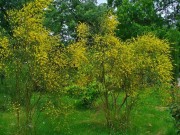
Discovered on the lava-strewn slopes of Italy’s Mt. Etna, this fantastic large shrub or small tree hosts sparsely arranged tiny green leaves and round arching slender green stems, creating an airy semitransparent effect. A fragrant sun-struck explosion of copious bright yellow pea-shaped flowers bedazzles its graceful narrow frame, which casts little shade and never overwhelms. Well-suited for lean, yet sharply draining soil, easily grown Genista aetnensis can take intense sun and heat, requires very little water, especially summer irrigation, will not reseed unlike its ill-mannered cousins and imparts untold elegance to a warm sheltered spot.
Blooms July–September.
Size: 12' 0" – 20' 0" high x 12' 0" – 15' 0" wide.
Zone 7/8.
Grevillea victoriae ‘Marshall Olbrich’ (S-0744)
Each $16.50

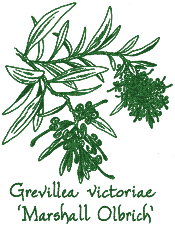
Though this superior evergreen form was selected at Western Hills Nursery in California, the species hails from both Australia and South America and is thought to be 130 million years old.
Silky gray upright twigs are attractively cloaked in long, silver-hued Willow-like leaves. Dangling from fast growing arching stems and favored by hummingbirds, the large showy clusters feature beak-shaped buds and richly hued, orange-red Honeysuckle-style flowers autumn through winter and sporadically throughout the year.
One of the hardiest Grevillea cultivars, it can accompany Mahonia ‘Charity’ in a warm well-drained slightly dry spot.
Blooms September – March.
Size: 6' 0" high x 8' 0" wide.
Hardy to zone 7.

Lovely, yet tough and drought resistant, x Halimiocistus is a cross between the genera Halimium and Cistus. This small-scale evergreen cultivar was raised at Merrist Wood Horticultural College in 1970.
Its low spreading form hosts soft yellow flowers embellished with wine-red spots at the base of each petal and narrow gray-green leaves. ‘Merrist Wood Cream’ is a favorite of ours en masse, as a rockery specimen, or blended with Nepeta, Lavender and Teucrium f. ‘Azureum’.
Blooms May–June
Size: 3' 0" high x 3' 0" wide.
Hardy to zone 7.
Hebe
Once you get to know this eternally appealing genus, it is easy to see why it was named after the Greek goddess Hebe who symbolized youth and immortality. With trim, tidy habits that convey a chipper attitude, our evergreen selections hail from New Zealand, serving up an irresistible dose of small dapper leaves aligned in alternating pairs all year long, and from summer until fall slender tapered racemes borne at foliar axils. Indispensable for seashore gardens, these former members of the Veronica genus make top-notch container plants in colder climates, appreciate a light spring shearing and can handle wind, some drought and sunshine galore.
OUT OF PRODUCTION AT THIS TIME
Email me when this plant is available
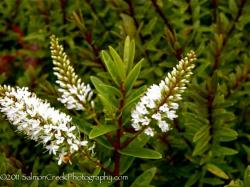
A pint-sized gem tailor-made for a small spot, ‘Champagne’ offers neatly arranged, tiny slender leaves in deep olive-green and purple hues dramatically set off by wine-colored stems, and quantities of white spikey blooms tinged with mauve.
This handsome Hebe quickly fashions a low spreading frost hardy ground cover that guarantees year-round appeal whether it’s positioned in the rockery, in a container or clipped as a small hedge.
Blooms August–early November.
Size: 2' 0" high x 3' 0" wide.
Hardy to zone 8.
Hebe odora ‘New Zealand Gold’ (S-0630)
OUT OF PRODUCTION AT THIS TIME
Email me when this plant is available
Known as the Boxwood imposter, this strong growing, compact Hebe is the perfect choice for hedging or topiary. Shoot tips and small, stiff pointed green leaves show off polished yellow-tinged hues while densely clasping light, sunny green stems. If left unclipped, it still looks impeccably ordered, forming a perfect little bun that occasionally cuts loose with white tapered blooms unfurling from green buds.
Blooms May–June.
Size: 20" high x 2-1/2' wide.
Hardy to zone 8.
Hebe pimeleoides ‘Quicksilver’ (S-0590)
Each $12.25
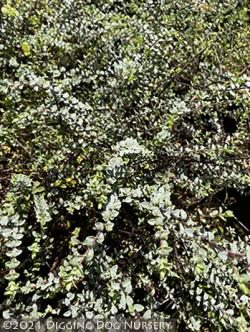
Indigenous to New Zealand, this AGM-winning evergreen shrublet promotes a versatile low-growing wiry habit. The arching whipcord-like black stems sparkle with spiky pale lilac blooms and petite, silvery blue-green leaves that are neatly arranged in closely set opposite pairs. Enjoying cool summers, mild winters, adequate moisture and fast-draining nooks, ‘Quicksilver’s unique colors and remarkable texture can grace containers, mixed borders and cut arrangements.
Blooms June–July
Size: 12" – 18" high x 2' 0" – 3' 0" wide.
Zone 7/8.
Each $12.25
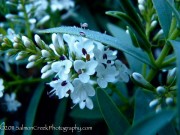
Shrouded in hushed gray-greens, Hebe recurva’s rounded visage conveys its composed character. A bushy array of glaucous, sickle-shaped narrow leaves, whose tips curve downward, elegantly garbs the red-tinged, slender stems and come summer, broadcasts infinite, snowy white Veronica-like spikes. One of the hardiest Hebes, this cool-colored shrub will easily fit in any garden, and looks especially alluring when sited amid Geranium lancastriense and Helianthemum ‘St. Mary’s’.
Blooms June–July.
Size: 2' 0" high x 2' 0" wide.
Hardy to zone 8.
Each $15.00


An unusual member of a small curious genus that venerates Georg Helwing, a German pastor and scholar on Prussian flora, this attractive multistemmed evergreen was collected during Dan Hinkley's 1996 expedition to China's Sichuan Province. Willow-shaped dark green foliage defined by a lustrous finish, maroon tinges and minutely toothed margins, alternately cloaks smooth green upright stems and generates unique flowers—tiny cream-colored spheres perched upon its midribs. Yielding a reputed remedy for skin inflammations, Helwingia chinensis bestows colorful year-round accents upon the woodland garden, where it relishes light shade, well-drained soil and regular moisture.
Blooms May.
Size: 6' 0" – 8' 0" high x 3' 0" – 5' 0" wide.
Hardy to zone 7.
Heptacodium miconioides (S-0344)
Each $18.75
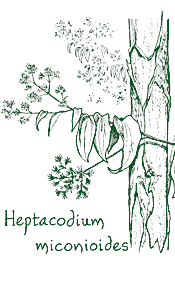
First discovered in China and brought to the West by the famous plant explorer E. H. Wilson, this awe-inspiring deciduous shrub provides unique points of interest no matter what the season. In spring, there is the foliage: large, narrowly heart-shaped, glossy and rich green, donning 3 deep veins. Then there is the exfoliating bark, which peels in thin strips to reveal a cinnamon-brown color. Early autumn brings the showy fragrant floral display, for which the species is named: 6 jasmine-like milky-white blooms held in tiered whorls on branch tips. Late autumn replaces blooms with small rounded purplish fruits surrounded by luxe long-lasting rosy-pink calyces. Excellent as a specimen, Seven-Son Flower thrives in most garden soil types.
Blooms September–October
Size: 10' 0" – 20' 0" high x 16' 0" wide.
Hardy to zone 5.
Hydrangea
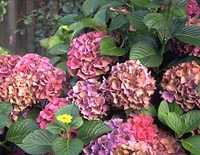
Climbing Hydrangea
The name Hydrangea, means “water vessel,” given for its cup-shaped seed capsules. A genus of diverse forms, Hydrangeas are commonly found throughout Asia, from the Himalayas to Taiwan and Japan, with the exception of two species, Hydrangea arborescens and Hydrangea quercifolia, which are native to North America. Easily cultivated, this shrub’s lush deciduous leaves are best suited to loose, moist soil in the shade of tall trees or on the north side of the house.
In cultivation for more than 60 years, this robust sumptuously colored German cultivar is still considered one of the finest mopheads. Pale green stems and bold, waxy and somewhat wrinkled medium green foliage sculpt its dense, small-statured globular form. A vivacious deep rosy red bedazzles each alluring rounded flower, defined by attractively spaced individual florets with pointed tips and upturned edges. Surprisingly sun tolerant, the red-tinged foliar margins echo the bloom hues, while autumn brings a suffusion of dark maroon to the entire leaf.
‘Glowing Embers’ is second-to-none for the smaller garden and promises to parade its marvelous hues for several months if a soil pH of 6.5 is maintained.
Blooms July – August.
Size: 3' 0" – 4' 0" high x 3' 0" – 4' 0" wide.
Hardy to zone 6.
Hydrangea arborescens ‘Annabelle’ (S-0048)
Each $17.75
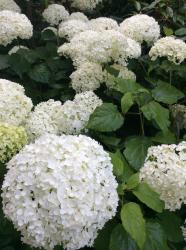
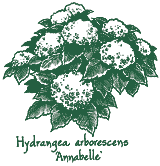
‘Annabelle’ is “unabashedly the queen of the Hydrangea arborescens cultivars”, wrote esteemed horticulturist, Michael Dirr, and we wholeheartedly concur! Named and introduced by the late great plantsman, J. C. McDaniel, this superior native Hydrangea was first found along a wooded trail over 100 years ago in the small town of Anna, Illinois. The lovely spectacle of immense, foot wide pure white snowballs with closely clustered sepals, concealing fertile flowers and thick celery-colored stalks with broad mint green serrated leaves, is a cool antidote to the stickiest summer day. Steeped in old-fashioned feminine appeal, ‘Annabelle’ luxuriates as a dense dramatic specimen next to Deutzia ‘Nikko’ and Phlomis ‘Amazone’.
Blooms August–October
Size: 3' 0" – 6' 0" high x 4' 0" – 6' 0" wide.
Hardy to zone 4.
Hydrangea arborescens ‘Haas Halo’ (S-0789)
OUT OF PRODUCTION AT THIS TIME
Email me when this plant is available
Discovered in 2008 and newly introduced, this spectacular native cultivar sprung up as a chance seedling in a Pipersville, PA garden. ‘Haas’ Halo’ premiers massive, 12 in. wide lace-caps with up to 50 good-sized sterile florets hoisted above an upright deciduous foundation, whose strong sturdy stems easily support the snowy-white extravaganza. Large, round, pointed leaves imparting bluish overtones compose a leathery green foil for the magnificent flowers that sustain a comely dried presence some 6 months after they’ve stopped blooming. Though the precise lineage remains uncertain, its stalwart demeanor is known to tackle heat, humidity and drought as well as enliven just about any planting bed. (PPAF)
Blooms June–August
Size: 3' 0" – 5' 0" high x 3' 0" – 5' 0" wide.
Hardy to zone 3.
Each $19.50
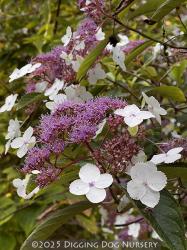
An elegant deciduous mainstay for dappled shade or north-facing sites, this magnificent large rounded Hydrangea headlines good-sized bluish purple lace caps and big ovate-shaped dark green foliage that imparts a velvet-soft tropical aspect. Pronounced knob-like deep rose-hued buds appear early, but wait ’til late summer to unfurl an iridescent delicacy of dense pale blue heads ringed with serrated mauve florets. Adored by bees, fabulous in dried arrangements and highly responsive to pruning, show-stopping ‘Villosa’ guarantees long lasting end-of-the-season grandeur.
Blooms August–October
Size: 6' 0" – 8' 0" high x 6' 0" – 8' 0" wide.
Hardy to zone 6.
Hydrangea aspera ‘Rocklon’ (S-0421)
Each $19.50
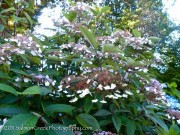
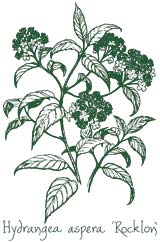
Large pink clouds of buds and pinkish bronze, downy new growth bring a soft look to this noble, rarely cultivated Hydrangea. Mounted on stout fuzzy stems, wide, hairy serrated foliage, with red-hued petioles, provides a graceful deep green foil for the enormous mauve lacecaps ringed by white bracts. Adequate water and bright shade will ensure ‘Rocklon’s prosperity, while Corydalis and Stylophorum diphyllum offer contrasting texture beneath.
Blooms August–mid-November.
Size: 10' 0" high x 8' 0" wide.
Hardy to zone 7.
Paying homage to its late Dutch creator, this lovely, reliable lacecap is closely allied to Hydrangea aspera, a much larger relation. Borne on new wood, big acorn-shaped green buds unfurl a prolific late season parade of soft-looking, fertile bluish lavender flowers surrounded by sterile 4-sepaled white blooms, some infused with the palest blue. Somewhat fuzzy, slender-pointed and finely serrated matte green leaves cloak the medium-sized foundation that’s well-suited for smaller-scaled gardens. Partial shade plus organic-laden, adequately moist soil ensure vigorous growth and ethereal long-lasting floral effects. (pp#21,991)
Blooms July–September
Size: 2' 0" – 4' 0" high x 2' 0" – 4' 0" wide.
Hardy to zone 6.
Superior cold hardiness and guaranteed blossoms give you good reason to invite this plucky small-sized Hydrangea into your planting bed. Since the buds are formed on new wood, the amazing bounty of 6 in. wide, buxom blue mop-heads promises to unfold each summer, regardless of the previous winter’s severity. Well-formed branches and neat, serrated, broad deep green leaves bolster the long-lasting flowers that retain their opulent coloration for weeks and look classy in cut arrangements. Second-to-none where space is a premium, ‘All Summer Beauty’ requires less winter protection than most macrophylla, transmutes buttery-yellow fall color and makes a flower-laden addition to foundations or patio containers.
Blooms June–September
Size: 3' 0" – 4' 0" high x 3' 0" – 4' 0" wide.
Hardy to zone 5.
Hydrangea macrophylla ‘Blue Wave’ (S-0302)
Each $17.75

This choice lacecap Hydrangea deserves center stage, where its lovely broad flowers, in shades of lilac to bright blue, can create a colorful splash. Brushed with streaks of claret as they mature, the blossoms are still alluring in November, and if picked at the right time will dry to an exquisite silvery blue. The robust handsome foliage often displays a glossy surface plus burgundy-hued margins as it cloaks red-speckled green branches. ‘Blue Wave’ is irresistible next to Philadelphus ‘Belle Etoile’, while golden-leafed Carex skirts below.
Blooms mid-August–November
Size: 5' 0" – 6' 0" high x 4' 0" wide.
Hardy to zone 6.
Hydrangea macrophylla ‘Enziandom’ (S-0718)
OUT OF PRODUCTION AT THIS TIME
Email me when this plant is available
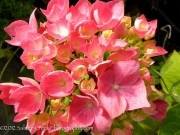
Bred nearly 70 years ago, this vivid, bright cobalt blue mophead is coveted by both florists and landscapers. Overlapping, white-eyed cupped florets mature to pure blue, taking on a flatter appearance, while the large gorgeous blooms later exhibit rich plum hues dappled with smoky blue tinges.
Second-to-none for cutting and drying, the lavish flowers can last through October, festooning a medium-sized, coarse textured shrub whose dark green, maroon edged leaves transmute coppery wine autumnal shades. Euphorbia ‘Limewall’s chartreuse floral bracts create a flashy union.
Blooms July–October
Size: 3' 0" – 4' 0" high x 5' 0" wide.
Hardy to zone 5.
Hydrangea macrophylla ‘Hörnli’ (S-0720)
OUT OF PRODUCTION AT THIS TIME
Email me when this plant is available
Boasting a plethora of late blooming, bold, bright crimson mopheads, this delectable small-sized Hydrangea originated in Wadenswil, Switzerland. The nonoverlapping sepals crowd onto a compact 4 to 5 in. domed cluster, enhanced by fuzzy looking, prominent fertile flowers.
Well-suited for the front of the border, a patio or a container, ‘Hörnli’s handsome, red-rimmed and toothed, matte green leaves cloak a neat vigorous shrub that easily nestles into a tighter spot, never needs pruning and promises to gratify.
Blooms August – October.
Size: 20" – 2' 0" high x 2' 0" wide.
Hardy to zone 6.
Hydrangea macrophylla ‘Horcos’ (S-0849)
Each $17.75
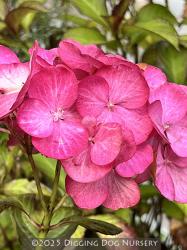
A 2016 introduction from Dresden, Germany, ‘Horcos’ fashions large domed flowers whose semidouble dark reddish pink florets mature with prominent creamy-white eyes. Flaunting nearly twice as many florets as other mopheads, the unique bicolored blooms stage a breathtaking richly hued presentation all summer long atop strong, thick green stems and lusty, broad serrated greenery. This average-sized floriferous Hydrangea can be massed, planted as a specimen in a mixed border or blanketed beneath by a carpet of white-blooming Geranium ‘St. Ola’. Alkaline soil promotes warm rubescent shades while neutral and acid sites will produce either blue or violet-hued blossoms. (pp#27,110)
Blooms June–September
Size: 3' 0" – 4' 0" high x 4' 0" – 5' 0" wide.
Hardy to zone 6.
Hydrangea macrophylla ‘Lanarth White’ (S-0161)
Each $17.75
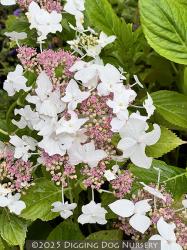
While this enticing AGM winner was discovered in Lanarth, Cornwall and similar-looking white lacecaps can be found growing in Japan, its precise origin still remains somewhat of a mystery. Poised above finely serrated broad pale green leaves and unspeckled green stems, irregularly spaced white-as-snow florets perform a lacy dance around medium blue or lilac-colored fertile flowers. Full sun exposures (when accompanied by even moisture), sea side abodes and poor soil seldom impede its shapely habit from displaying a wealth of elegant blooms, which make superb porcelain-hued additions to dried arrangements.
Blooms July–September
Size: 3' 0" – 5' 0" high x 3' 0" – 5' 0" wide.
Hardy to zone 6.

The unusual foliage of this smaller statured Hydrangea will surely bring a “wave” of interest to a shady garden spot. Each leaf is uniquely marked: some are porcelain to cream with lemon yellow margins. Others are green, ranging from emerald through mint to chartreuse. The lacecap flowers can vary in color as well, all the way from white to mauve to blue.
Blooms June–August.
Size: 4' 0" – 5' 0" high x 4' 0" wide.
Hardy to zone 6.
Hydrangea macrophylla ‘Maculata’ (S-0157)
OUT OF PRODUCTION AT THIS TIME
Email me when this plant is available
Broad serrated mint green leaves, artfully bordered or otherwise splashed with porcelain white, give you good reason to grow this moderately sized dome-shaped Hydrangea. Viewed from a distance, the variegated foliage translates to soothing olive-hued tones, effectively creating a lush first-rate oasis in the midst of deep greens and finer textured plants. The classy lacecaps, which sport tiny fertile deep gentian blue florets surrounded by large sterile pale blue petals, are the icing on the cake. Well-suited for gardens where space is limited, �Maculata� prospers in dappled light and well-drained, somewhat moist soil.
Blooms June–August
Size: 3' 0" – 4' 0" high x 4' 0" – 5' 0" wide.
Hardy to zone 6.
Hydrangea macrophylla ‘Madame Emile Mouillère’ (S-0719)
OUT OF PRODUCTION AT THIS TIME
Email me when this plant is available
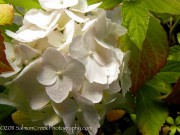
Gracing gardens for an entire century, this vintage French glamor queen parades quantities of large, pure white flower clusters. The rounded mopheads include tightly packed serrated florets, which eventually open wide and push up against one another to produce a frilly feminine silhouette.
Blooming on both old and new wood, and appreciating protection from hot sun, the stylish blossoms bounce back after a rain, unfurl until late in the season, and make unparalleled cut flowers, fresh or dried, while showcasing soft pink and lime-green brush strokes as they age.
The tall robust frame, supported by unspotted stems and smooth, notched glossy green foliage, can be situated along a sheltered shady garden wall or the north side of a house.
Blooms June – August.
Size: 6' 0" high x 6' 0" wide.
Hardy to zone 5.
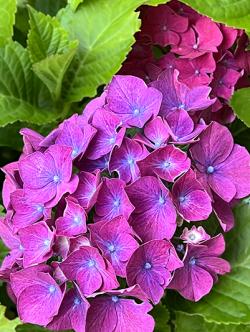
Hoisted aloft by a trim lustrous foil of broadly-ovate dark green foliage, the large close-knit ball-shaped mop-heads flash vibrant reddish magenta colors that slowly develop mulled metallic shades. Wowing floral artists and garden visitors alike, ‘Masja’s long-lasting flowers are big on drama, while its snug mid-sized profile is well-suited for smaller gardens, and can be utilized as a low hedge or featured as a bold container subject. Acidic conditions will cause the blooms to err towards blue-violet.
Blooms July–September
Size: 3' 0" – 4' 0" high x 3' 0" – 4' 0" wide.
Hardy to zone 6.
Widely acclaimed in many gardening circles as one of the best Hortensias, this compact eye-catching Hydrangea sports a deciduous medium growth habit, lustrous dark green elliptical leaves and big colorful frilly mopheads. The close-knit midsummer flowers are defined by large prominently serrated sepals and opulent prismatic shades that range from yellowish green, deep blue and royal purple to pink, depending on the soil pH. Long lasting, plentiful, ideal for bouquets, fresh or dried, and intensely pigmented, ‘Mathilda Gutges’s blooms promise to please.
Blooms July–September
Size: 4' 0" high x 3-1/2' – 4' 0" wide.
Hardy to zone 6.
Hydrangea macrophylla ‘Nigra’ (S-0827)
Each $17.75
Named for its lustrous, stout ebony-infused deep purple stems, this arresting E. H. Wilson introduction received an RHS First Class Certificate in 1895 and has been popular ever since. Large, plush white-veined bright green leaves garb the undemanding rounded profile, while late season creamy white buds develop into speckled mop-heads that range from rosy mauve to blue, depending on the pH. Grateful for a well-composted mulch and shelter from extracold winter weather, ‘Nigra’ can be planted in eye-catching drifts or as a deciduous specimen in a mixed border.
Blooms June–August
Size: 4' 0" – 6' 0" high x 4' 0" – 6' 0" wide.
Hardy to zone 6.
This compact lacecap Hydrangea deserves center stage, where its broad, light blue flowers and dense green foliage can create a colorful splash. Handsome and verdant, the glossy leaves, which are narrower than those of the species, display a tasty reddish plum hue in late summer and fall. A drift of ‘Blue Billow’ is irresistible next to Philadelphus ‘Innocence’, while golden-leafed Hakonechloa skirts below.
Blooms June–August.
Size: 4' 0" – 5' 0" high x 4' 0" wide.
Hardy to zone 6.
Hydrangea macrophylla ‘Shooting Star’ (S-0760)
Each $17.75
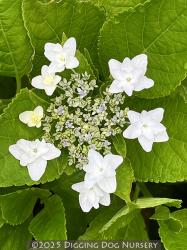
A starry cascade of layered sterile florets on long slender pedicels and small round fertile flowers comprises the softly domed white heads, each shaped like a unique hybrid between a lace-cap and a mop-head. Delivering fluid illuminated accents similar to exploding fireworks, and a repeat autumn bloom, the 12 in. wide gossamer-style flowers are set against large, gleaming dark green deciduous leaves with serrated margins and a waxy finish. Well-known in its Japanese homeland, though rarely offered here, this phenomenal Hydrangea makes an enduring artful choice for the shrubby border, a dynamic sweep or a big terracotta pot.
Blooms July–October
Size: 3' 0" – 5' 0" high x 3' 0" – 5' 0" wide.
Hardy to zone 5.
Hydrangea macrophylla ‘Soeur Thérèse’ (S-0863)
Each $17.75
A refined beacon of long-lasting loveliness, large, rounded pure white mop-heads house slightly lax florets that transmute chartreuse tones coupled with red streaks as they age. Well-loved in Britain since the 1950s, this attractive tightknit deciduous Hydrangea bears upright slender stems garbed in winsome ovate and serrated dark green leaves. Easily grown ‘Soeur Thérèse’ craves protection in cold winter locales, and lends a fresh classic touch to patios, containers, formal or informal plantings plus fresh and dried arrangements.
Blooms July–September
Size: 4' 0" – 6' 0" high x 5' 0" – 6' 0" wide.
Zone 7b.
Hydrangea macrophylla ‘Nikko Blue’ (S-0898)
Each $17.75
Hydrangea paniculata ‘Limelight’ (S-0612)
Each $19.50
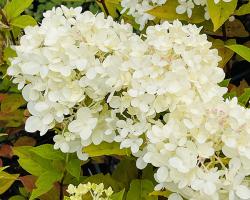
An awe-inspiring beauty whose blooms first open in creamy white elegance, transition to lime-green until fall, and finally turn deep pink, this vigorous Dutch cultivar deserves to be in the limelight. Strong, upright stems cloaked with handsome greenery shoulder the elegant, cone-shaped trusses, which impart a crisp, refreshing sophistication to the shrubby border or a bouquet. (PP#12,874)
Blooms late July–September.
Size: 6' 0" – 8' 0" high x 6' 0" – 8' 0" wide.
Hardy to zone 4.
Hydrangea paniculata ‘Mega Mindy’ (S-0773)
OUT OF PRODUCTION AT THIS TIME
Email me when this plant is available
Selected by plant breeder, Dr. Johan Van Huylenbroeck and named after a Flemish children's super hero, this fantastic recently introduced Hydrangea develops into a sturdy fast growing deciduous shrub with broad deep green veined leaves and strong compact branches that proudly uphold a marvelous action-packed floral display. Large conical heads, emerging pure white and gradually broadcasting rosy red shades in late summer, make exquisite additions to cut arrangements, fresh or dried, and assert long lasting loveliness, even to a frosty midwinter landscape.
Hardy, adaptable and easily pruned for smaller garden spaces, 'Mega Mindy' looks valiant as a coarsely textured specimen along a woodland's edge amid swaths of fine bladed grasses like Sesleria and Pennisetum. (pp#23,070)
Blooms early July–October
Size: 5-1/2' high x 4-1/2' wide.
Hardy to zone 3.
Hydrangea paniculata ‘Pink Diamond’ (S-0420)
Each $19.50
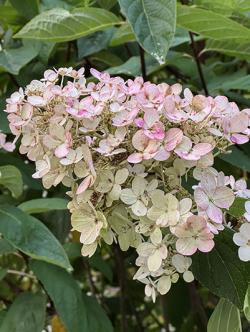
An upright and rounded, compact cultivar, this exceptional deciduous shrub arose from a 1980s selection of Hydrangea ‘Unique’ seedlings. Amid handsome, ovate dark greenery, ample pink buds unveil magnificent, dense, creamy-white panicles poised on staunch red-tinged stems. The dramatic progression of color begins as pink hues develop at each flowers base and gradually darken toward its tip, saturating the entire blossom with antique deep rose shades. Late-blooming ‘Pink Diamond’s grand textural profile can be planted, either singularly or massed, plus added to hedges, mixed borders or open woodland gardens, while its posh pyramidal blooms bestow winter interest and make fantastic dried or fresh cut flowers.
Blooms July–October
Size: 6' 0" – 8' 0" high x 5' 0" – 7' 0" wide.
Hardy to zone 5.
Hydrangea paniculata ‘Silver Dollar’ (S-0876)
Each $19.50
Carefully selected by Dutch plantsman Peter Zwijnenburg, this compact AGM champ puts on the ritz as posh tightknit creamy-white trusses first unfurl with greenish tones, then develop a pink blush in late summer. Perched upon staunch dark crimson-brown stalks and pointed deep greenery, the large broadly-rounded conical heads sport mostly fertile flowers, which lend luminous accents to fresh and dried arrangements. ‘Silver Dollar’s undemanding well-branched habit makes a sterling specimen for smaller gardens, affording a long-blooming season plus textural allure.
Blooms July–October
Size: 5' 0" high x 5' 0" wide.
Zone 4b/5.
Hydrangea paniculata ‘Unique’ (S-0348)
OUT OF PRODUCTION AT THIS TIME
Email me when this plant is available
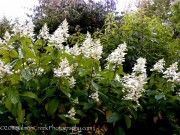
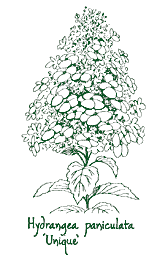
Left to its own designs, this vigorous Hydrangea has a natural upright and arching form, but it also responds well to pruning, making ‘Unique’ an effective choice where space is scarce.
The immense flower heads are spectacular and abundant, and true to name are unique in shape, being quite broad at the base and bluntly rounded at the tip. They begin the season a creamy white and gradually darken to a buff pink.
Blooms early July–October
Size: 10' 0" high x 8' 0" wide.
Hardy to zone 3.
Hydrangea quercifolia ‘Alice’ (S-0323)
Each $19.50
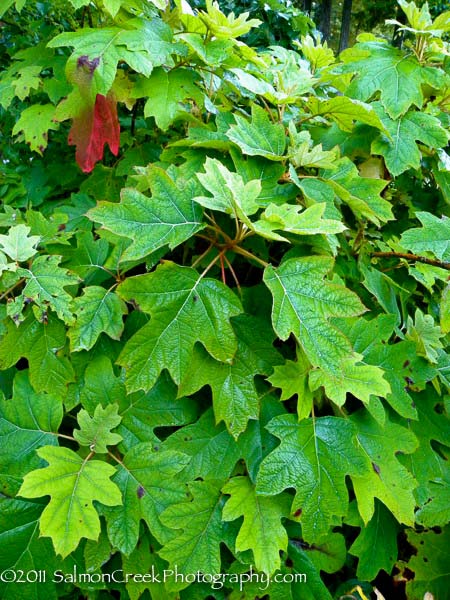
We have Mike Dirr to thank for this vigorous selection. Tall and fast growing, ‘Alice’ displays large, very delicate, lacy looking white flower heads, and the show continues when the broad green oak-shaped leaves turn deep carmine in autumn. For contrast, try planting an understory of Persicaria ‘Red Dragon’.
Blooms July–September.
Size: 10' 0" – 12' 0" high x 8' 0" – 10' 0" wide.
Hardy to zone 5.
Hydrangea quercifolia ‘Amethyst’ (S-0737)
OUT OF PRODUCTION AT THIS TIME
Email me when this plant is available
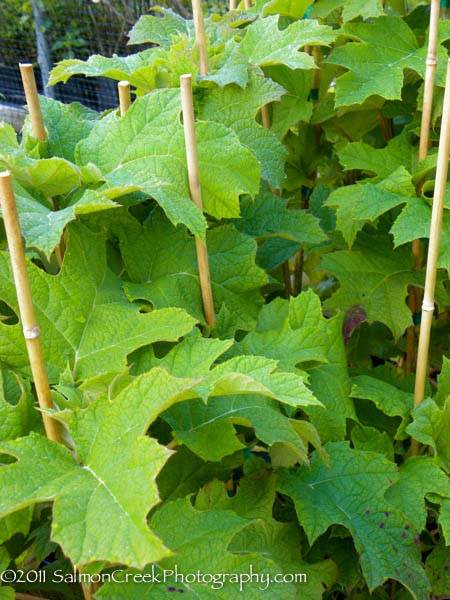
Yet another first-class shrub introduced by esteemed horticulturist, Michael Dirr, this steadfast smaller-sized cultivar commands our attention. The 6 in. long, upright flowers house creamy white sepals, which darken to a luscious wine-red hue as they mature and make exceptional fresh or dried cut flowers, maintaining their rich hues. Ideal as a stand-alone or massed, easy-to-grow ‘Amethyst’ sports handsome, large coriaceous leaves with a spectacular fall showing of burgundy shades.
Blooms July – September.
Size: 5' 0" – 6' 0" high x 5' 0" – 6' 0" wide.
Hardy to zone 5.
Hydrangea quercifolia ‘Queen of Hearts’ (S-0805)
Each $19.50
Recently released by the National Arboretum’s highly touted shrub breeding program, this colorful ‘Snow Queen’ and ‘Pee Wee’ hybrid was selected for its long lasting profusion of huge upright conical white blooms and the antiqued deep pink tones they transmute when they mature. Even without the extravagant 9 in. flowers, ‘Queen of Hearts’s rounded medium statured frame can be successfully utilized in shrubby borders or planted in drifts, where its typical Oak Leaf foliage vaunts dashing textural accents and rich rubescent fall colors.
Blooms July–October
Size: 6-1/2' high x 6' 0" – 8' 0" wide.
Hardy to zone 5.
Hydrangea quercifolia ‘Ruby Slippers’ (S-0766)
Each $19.50
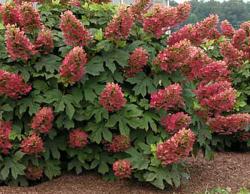
Easily slipped into a diminutive spot, this compelling smaller statured beauty sprung from a 1998 U.S. National Arboretum cross between ‘Snow Queen’ and ‘Pee Wee’. Fabulous 9 in. upright flowers, which open white but quickly transmute pale pink and eventually deeper rose hues, dress up a more petite, compact rounded carriage. Broad, lobed deciduous leaves are dark green in summer and mahogany-tinted come autumn. A peerless companion for fine textured plants such as Spiraea ‘Ogon’ or Sarcococca hookeriana var. humilis, ‘Ruby Slippers’s attractive low silhouette can be ushered to the foreground, planted en masse or utilized as a hedge.
Blooms July–September
Size: 3-1/2' high x 5' 0" wide.
Hardy to zone 5.
Hydrangea quercifolia ‘Sikes Dwarf’ (S-0566)
Each $19.50
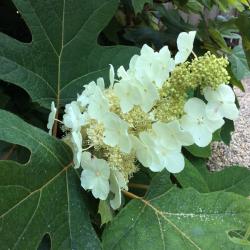
Sarah Sikes deserves a round of applause for this low growing Oak Leaf Hydrangea. Hailing from Alabama, it’s half the size of most quercifolias, rendering it a mainstay in the smaller garden. Lobed and closely set, the handsome broad foliage shows off abundant ivory-colored conical blooms. Surround with leaves of like shapes such as Anemone and Kirengeshoma to complement ‘Sikes Dwarf’s unparalleled foliar texture.
Blooms July–August
Size: 3' 0" high x 4' 0" wide.
Hardy to zone 5.
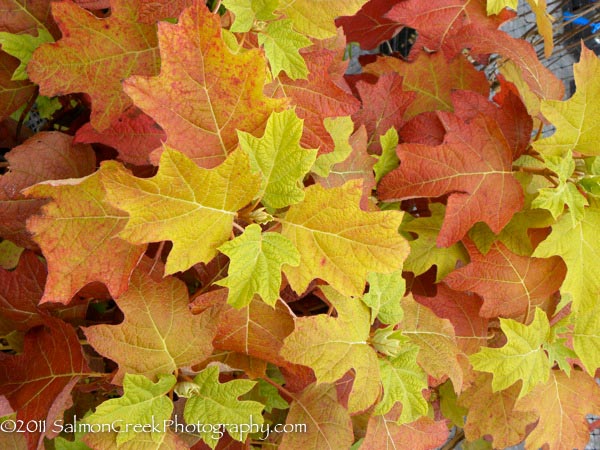
Though its name might make you think otherwise, this hardy shrub also showcases variable earth tones. Its 8 in. long panicles of white flowers, which later take on a pinkish hue, stand out like snow against the beautiful exfoliating cinnamon-brown bark and large Oak-like dark green leaves that turn reddish purple in autumn. Undemanding ‘Snow Queen’ offers a fantastic fall display alongside Panicum ‘Warrior’ with its contrasting form and similar colors.
Blooms July–August
Size: 4' 0" – 6' 0" high x 6' 0" wide.
Hardy to zone 5.
Hydrangea quercifolia ‘Snowflake’ (S-0124)
OUT OF PRODUCTION AT THIS TIME
Email me when this plant is available
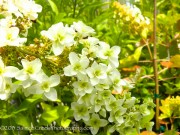
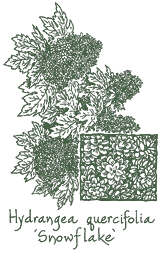
It was a fortuitous moment when Hydrangea enthusiast Eddie Aldridge and his father happened upon this sumptuous Hydrangea in the woodlands of Jefferson County, Alabama. Premiering enormous, 15 in. long white panicles that can extend upward, outward or pendulously, the coarse textured, leathery anchor of large, Oak-like foliage burnishes deep burgundy come fall and stays intact well into December. The distinctive, two-toned double-petaled effect is created when numerous tiered sepals initially open white, while below the older ones develop dark dusty-pink shades with age. ‘Snowflake’s blossoms unfurl a little later and seem to last longer than the single-flowering quercifolia plus Michael Dirr considers them to be the most beautiful of the sterile-blooming cultivars.
Blooms late July–September
Size: 6' 0" – 8' 0" high x 6' 0" – 8' 0" wide.
Hardy to zone 5.
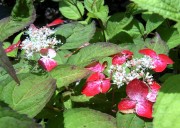
Beni translates “red” in Japanese, and red, specifically a darkly imbued red lacecap is what this small rounded shrub delivers. Originally collected from a wild clone, its graceful form cushions dainty flowers that first emerge blushed white and gradually deepen to rubescent shades, the rich, stop-in-your-tracks color persisting on the sepals well into autumn. With cool green leaves and ardent inflorescences, ‘Beni’ is a dynamic choice for a tight space.
Blooms mid-July–September.
Size: 4' 0" high x 4' 0" wide.
Hardy to zone 6.
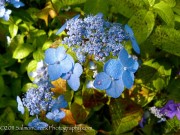
A sterling, highly sought after progeny of renown horticulturist and Hydrangea expert Michael Haworth-Booth’s breeding efforts, this low growing Hydrangea lulls us with cool, light blue lacecaps. The central fertile flowers are encompassed and sometimes hidden by prominent serrated sepals that later transmute sea-green and lilac-purple in sumptuous, glimmering shades. Compact and closely set, red-dashed green stems shape its attractive dwarf frame, while launching a fiery autumnal pageant of purple-rimmed, cardinal-colored leaves soon after the prolific blooms begin to fade.
Blooms July–September.
Size: 4' 0" high x 4' 0" wide.
Hardy to zone 6.
Exquisite long blooming lacecaps, whose flowers uniquely turn upside down and reveal pink undersides in late summer, plus brilliant copper red foliar fall colors are ‘Bluebird’s claim to fame. The robust, yet slow growing compact habit is defined by large pointy dark green leaves, unspotted stems and flattened gossamer-like bluish mauve inflorescences, presenting clustered rich blue fertile blossoms and 4 rounded sepals, which create the shape of a cross. Ideal as a deciduous container subject, this cold-hardy AGM recipient exhibits the bluest floral coloration in acidic soil and looks spectacular either en masse or positioned singularly on the fringes of a woodland garden.
Blooms June–October
Size: 3' 0" – 5' 0" high x 3' 0" – 5' 0" wide.
Hardy to zone 6.
Straight from the slopes of Japan’s Mt. Kiyosumi comes this spectacular deciduous Hydrangea acclaimed for its classy pink lacecaps and lavish burgundy and henna-flushed new growth. Springing from ruby-red buds, the rosy picotee sterile florets are narrowly rimmed in red and eventually fade to white atop a compact rounded bushy habit. Broad mature dark green foliage that’s highlighted with prominent veins garbs the purple spotted stems. Medium sized and undemanding, ‘Kiyosumi’ lends dazzling accents to any shady spot, especially when planted behind Parahebe linifolia.
Blooms July–September
Size: 4' 0" high x 4' 0" wide.
Hardy to zone 6.
Hydrangea serrata ‘Miranda’ (S-0631)
Each $18.25
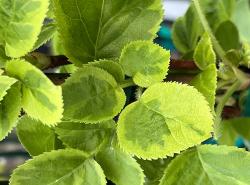
With unmatched delicacy, these exquisite inflorescences are defined by loosely spaced sepals wreathing around several separate, distinctive clusters of light blue, centrally arranged fertile flowers. The lacy, long lasting drama unfolds in varying shades from soft blue and mauve to nearly white to pale pink, sometimes donning streaks and swathes of different colors, depending upon the pH. Yellow-tinged green foliage attires this small-sized Hydrangea, and come autumn tints of claret warm the margins, veins and eventually the entire leaf.
A seedling selected by M. Haworth-Booth, ‘Miranda’s diminutive profile can be spotlighted in a patio vessel or anywhere its elegance is easily appreciated.
Blooms July–September.
Size: 3-1/2' – 4' 0" high x 3-1/2' – 4' 0" wide.
Hardy to zone 6.
Hydrangea serrata ‘O Amacha Nishiki’ (S-0774)
Each $18.25
Selected by the late great plantsman J. C. Raulston, this rare Japanese cultivar boasts dainty lacecaps with lilac or pink-blushed white florets poised upon a mesmerizing mound of gold-dusted green deciduous foliage. Pink petioles and striking maroon and red fall colors further highlight the extraordinary 5 in. long variegated leaves. Named after the sweet tasting amacha, a Japanese tea crafted from its dried leaves, ‘O Amacha Nishiki’ is a small-statured star specimen that’s well-suited for a mixed planting. It appreciates rich adequately-moist soil and protection from harsh afternoon sun inland, though tolerates full sun near the coast.
Blooms July–September
Size: 3-1/2' – 4' 0" high x 3-1/2' – 4' 0" wide.
Hardy to zone 6.
Hypericum
St. John´s Wort

Native to western Europe and North Africa, this handsome species’ common name comes from toute-saine (heal-all) and refers to the many healing properties the plant was once supposed to possess. Interesting throughout the year, Tutsan is a cure-all for lightly shaded garden areas that need some brightening up. The wine-infused stems and deep green foliage contrast beautifully with cheerful golden yellow flowers in summer, and later with glossy red berries, which eventually turn black. The weight of the fruit causes the branches to arch, giving the plant a relaxed look and making it perfect for shrubby borders.
Tutsan also does well in the sun, planted with Lavenders. In late summer, its colors make a striking combination with Nepeta ‘Wild Cat’ and Buddleja ‘Ellen’s Blue’.
Blooms June–early August.
Size: 4' 0" high x 4' 0" wide.
Hardy to zone 6.

In an ebullient “sunburst,” large 3 in. wide yellow petals cushion a spry central cluster of stamens that look like orange powder puffs. Dense stout branches plus oblong curvy leaves with soothing glaucous blue hues shape a compact round mound, revealing narrow reddish brown seed capsules through autumn and exfoliating purplish brown bark for winter appeal. Indigenous to our South-eastern limestone glades, this tailored semievergreen Hypericum can be massed or sited singularly in the mixed border where it triumphs over dry compacted soil and clay.
Blooms June–August
Size: 3' 0" – 4' 0" high x 3' 0" – 4' 0" wide.
Hardy to zone 5.

Enticing butterflies, florists and all who behold it, this newly introduced compact shrub makes an ebullient statement. The resilient well-branched frame is characterized by sturdy, upright red-tinged stems plus tasteful medium green foliage that remains evergreen during mild winters. Hosting big round golden buds, decorative pale green calyces, flashy yellow starbursts of bloom with prominent stamens and plump, bright red berries, ‘Compact Red’ keeps us mesmerized for months. Acquiescent to sunny sites, it’s tailor-made for gardens short on space, mixed borders or patio containers.
Blooms June–mid September
Size: 18" – 2' 0" high x 18" – 2' 0" wide.
Hardy to zone 6.
Hypericum kalmianum ‘Gemo’ (S-0775)
OUT OF PRODUCTION AT THIS TIME
Email me when this plant is available
Selected from our native American species, this exciting relatively new Danish cultivar premiers droves of small yet radiant yellow blooms with dense showy stamens, resembling miniature golden starbursts. Handsome bright green willow-shaped foliage and close-knit branches craft a neat bushy shrub that can be utilized as a low informal hedge or a stylish mounding ground cover. Small growing, sturdy and reliable, 'Gemo' delivers ample doses of flowery good cheer for months at a time followed by decorative pointed seed pods for added intrigue, while Geranium 'Walküre' and Aster divaricatus make worthy companions
Blooms June – September.
Size: 2' 0" – 3' 0" high x 2' 0" – 3' 0" wide.
Hardy to zone 5.
Hypericum kouytchense (S-0417)
Each $13.50
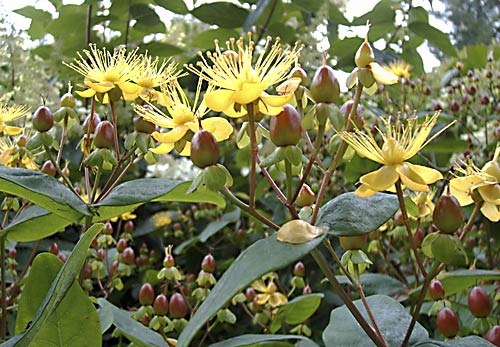
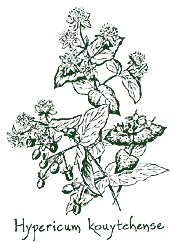
This truly elegant Hypericum is covered with an abundance of large, bright yellow, pointed buds, followed by golden yellow flowers whose prominent long stamens seem to sparkle. Against a background of smooth blue-hued leaves, the bright red berries and starlike calyxes make a colorful late season display. Though deciduous elsewhere, along our coast the aromatic leaves fill the garden with their scent all year round.
Blooms June–September
Size: 3' 0" high x 2' 0" wide.
Hardy to zone 5.

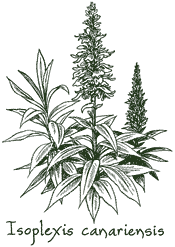
Forging a bold impression, this architectural beauty combines winsome, dark evergreen foliage on thick red-hued stems and foot long, noble spires in enticing autumn shades. Beneath a floral glow of gold, copper and orange, the large, downward-curving leaves are pointed, leathery and toothed, achieving an open, yet stiffly erect shrublike foundation that eventually becomes woody. Densely arranged, arching hooded flowers with three lower petals garnish the long blooming torches, casting their uniquely warm chroma on Melianthus major’s icy blue profile to great effect. Related to Digitalis and endemic to the Canary Islands, Isoplexis canariensis is a stately, medium-sized specimen for the mixed border requiring protection right around 25° and judicious trimming as it regenerates very slowly.
Blooms late May–October.
Size: 3' 0" – 4' 0" high x 3' 0" wide.
Hardy to zone 9.
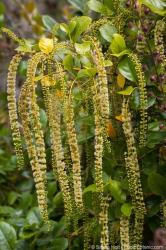
Discovered in 1895 along China’s Yangtze River by Scottish-born doctor, botanist and linguist Augustine Henry, this long-loved swank evergreen won its first British garden award in 1911. Lustrous, alternate leaves with small holly-esque, soft spiny margins craft an impeccably tailored rich green foil for the dazzling, draped floral display that charms bees, flower arrangers and plant connoisseurs. Small, dense greenish cream-colored flowers resemble elegant, slender foot-long catkins and waft a sweet honey scent. Intolerant of drought, yet resistant to deer and rabbits, Holly-Leaf Sweetspire can be featured as an easy-care screen, a stylish mixed border specimen along a path or espaliered against a fence or courtyard wall. Adequate moisture, partial shade plus shelter from strong winds and hot sun guarantee its success.
Blooms late July–October
Size: 10' 0" high x 10' 0" wide.
Zone 6b/7.
Itea virginica ‘Henrys Garnet’ (S-0219)
Each $17.25
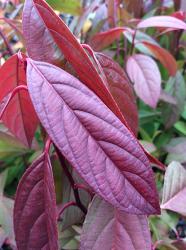
A superb multiseason landscape shrub and a popular pollinator haven, this versatile semideciduous selection of the native species was discovered at Swarthmore College in the early ’80s. Dangling from the tips of arching branches like thick strands of pearls, 6 in. long cylindrical racemes present petite, spicy-scented white flowers. The lustrous oval-shaped rich green leaves clothe a pleasing, upright and rounded compact habit that blazes long-lasting fall color marked by garnet-red, crimson and scarlet. Equally lovely en masse or as a specimen, easily grown ‘Henry’s Garnet’ adores low-lying damp areas, yet withstands dry soil, heavy shade and full sun.
Blooms May–June
Size: 3' 0" – 4' 0" high x 4' 0" – 6' 0" wide.
Hardy to zone 5.
Kerria
Kerria
Kerria japonica ‘Albiflora’ (S-0446)
Each $13.75
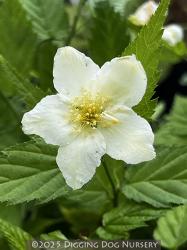
Pointed, pleated and serrated, the handsome bright green leaves loosely garb long wiry branches, which extend from the ground in a graceful open fashion, showcasing an abundance of rose-shaped, single, creamy white blooms with butter colored centers. Coveted by florists and gardeners, Japanese Rose achieves a welcome year-round elegance as radiant green polished twigs and upright bare branches retain their verdant color throughout the winter. This tough and undemanding deciduous shrub can be pruned after flowering, endures dry shady spots and likes welldrained soil.
Blooms April–May
Size: 3' 0" – 5' 0" high x 3-1/2' wide.
Hardy to zone 5.
Kolkwitzia
Beautybush
Originally selected in 1946 at Wisley’s Royal Horticultural Gardens, this reliable eye-catching old-timer delivers a splendid showing of broadly ovate dark green foliage and bell-shaped, yellow-throated clear pink blooms year after year. Arched suckering branches sculpt a pleasing vase-shaped shrub that features capsule-like fruit and attractive exfoliating bark once the clustered flowery profusion has faded. A deciduous deer resistant member of the Honeysuckle family and kin to Weigela, ‘Pink Cloud’s dense vigorous growth appreciates periodic thinning, even a late winter hard pruning and craves a well-drained sunny spot with moderate moisture.
Blooms April–May.
Size: 6' 0" – 9' 0" high x 5' 0" wide.
Hardy to zone 4.
Lavandula
Lavender
In the Middle Ages, Lavender was a chief ingredient in the famous “Four Thieves” vinegar, and today no classic sachet or potpourri would be complete without it. Dependable and drought tolerant, their strikingly handsome flowers, offer a heady aroma and an upright spiky look, while the foliage forms a pleasing year-round mound. In the herb garden, border or rockery, they combine well with grasses, perennials or other shrubs. If the plants are cut back in late June, many cultivars will produce a second bloom in autumn.
Lavandula x ‘Ana Luisa’ (S-0582)
Each $11.75
The foliage of this medium-sized Lavender has so much down that it almost appears white. Another angustifolia and lanata melding, ‘Ana Luisa’s shimmering silver leaves put forth tapered bluish lavender flowers with pearly calyxes in early summer, and cast a superb luminous effect during the colder months.
Blooms June–August.
Size: 2' 0" high x 2' 0" wide.
Hardy to zone 6.
‘Blue River’s compact, diminutive mound wafts a mighty perfume as droves of ample-sized, vibrant, deep blue blooms loll above. Garbed with spiffy, silver-washed green foliage, this consistently close-knit Lavender is tailor-made for containers, herb gardens or snug sunny spots.
Blooms June–August
Size: 14" high x 14" wide.
Hardy to zone 5.
‘Buena Vista’ tops many gardeners’ favorite Lavender list for its unequaled graceful stance plus oodles of sweetly fragrant, saturated purple flowers, blooming both early summer and fall. Not as densely arranged and somewhat more relaxed than most angustifolia species, long slender spikes carry pubescent, intensely dark violet-blue calyces coupled with large, vivid purplish blueberry-colored corollas above a full medium-statured gray-green foundation. Introduced by Don Roberts of Premier Botanicals, this classy, seldom offered English Lavender delivers year-round good looks, yields abundant commercial-grade oil and makes a savory seasoning to boot
Blooms June–mid-September
Size: 18" – 2' 0" high x 18" – 2' 0" wide.
Hardy to zone 5.
Introduced by Kieft Seeds of the Netherlands, this fantastic 2008 Fleuroselect Gold Medal winner offers a perfumed plethora of large vivid purple-blue flower spikes bolstered by swank silver-green slender leaves. ‘Ellagance Purple’ achieves an impeccable well-branched mound, that is compact and just right for nestling into tight spots.
Blooms July–August.
Size: 12" – 15" high x 18" wide.
Hardy to zone 5.
Lavandula angustifolia ‘Graves’ (S-0422)
OUT OF PRODUCTION AT THIS TIME
Email me when this plant is available
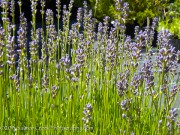
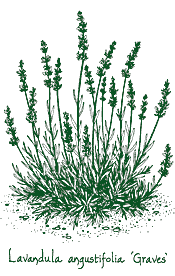
Tall slender stems rise from a mound of elegant sword-shaped gray-green foliage, the longest leaves of any angustifolia cultivar. Abundant green buds tinted with purple open into dark violet blooms held by light purple calyxes, and make excellent cut flowers, fresh or dried.
Blooms June–July.
Size: 2-1/2' – 3' 0" high x 3' 0" wide.
Hardy to zone 5.
Lavandula angustifolia ‘Imperial Gem’ (S-0479)
Each $11.75
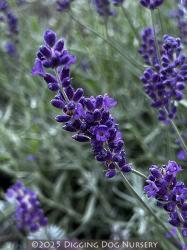
We favor this Lavender for its vibrant colored blooms. Topping grayish green, somewhat relaxed stems, opulent violet petals and fuzzy dark purple calyces form a broadly cylindrical head distinguished by a separate whorl of flowers at its base. A well-formed, midsized gray-green bush, ‘Imperial Gem’ makes a dazzling impression, especially when planted in drifts.
Blooms June–July
Size: 2' 0" high x 20" wide.
Hardy to zone 5.
Lavandula angustifolia ‘Melissa’ (S-0870)
Each $11.75
Introduced by Oregon’s Van Hevelingen Herb Nursery, this Lavender’s medium-sized upright and bushy appearance hosts fine-textured, dense frosted-green leaves. The sweetly fragrant, soft lavender-pink blooms, which age to white, are nestled within fuzzy violet-tipped green calyxes, beguiling bumblebees, hummingbirds and painted lady butterflies. Utilized in herbal rubs, aromatherapy and as a subtly favored culinary addition, no-quibble ‘Melissa’ casts soothing pastel grace notes amid rockeries, cottage gardens and Mediterranean plantings.
Blooms July–August
Size: 18" – 2' 0" high x 18" – 2' 0" wide.
Hardy to zone 5.
Lavandula angustifolia ‘Miss Katherine’ (S-0434)
OUT OF PRODUCTION AT THIS TIME
Email me when this plant is available
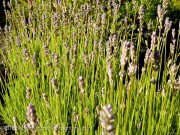
A hard-to-find English cultivar, ‘Miss Katherine’ is unquestionably the most exquisite pink flowering Lavender available. The long spindle-like blooms are colored a soft lilac-pink that’s brushed with lively red-violet tints. Held on tall, upright stems, they brighten the dense, shapely mound of gray-green foliage. Let a drift of this alluring and fragrant Lavender grace your herb garden.
Blooms June–July.
Size: 2-1/4' high x 2' 0" wide.
Hardy to zone 5.
Raised by a former RHS treasurer Charles Musgrave in the early 1930s, this award-winning compact cultivar has the most petite habit of all white-flowering Lavenders. The bushy well-groomed base sprouts narrow smoky-green leaves and slim semiupright short stalks, presenting green buds and a highly scented flurry of chubby pearlescent blooms with green calyces. Tailor-made for containers, ‘Nana Alba’ makes a steadfast and gleaming addition to white-themed venues, gravel gardens and coastal plantings as well as jams, ice cream and fresh or dried arrangements.
Blooms June–August
Size: 12" – 18" high x 15" – 2' 0" wide.
Hardy to zone 5.
‘Peter Pan’s stylish and snug ensemble becomes an aromatic grayish green foil for velvet-rich dark purple blooms atop short, sturdy 6 to 8 in. stems. Captivating either fresh or dried, violet-colored corollas plus dark purple calyces define the long-lasting bee-friendly floral fete. This diminutive, cold-hardy Lavender can be shorn into a low hedge, lodged along a pathway, featured in a container or added to a potpourri.
Blooms June–September
Size: 18" high x 2' 0" – 2-1/2' wide.
Hardy to zone 5.
This new award-winning Ellagance series member has a lot to parade: an exceptional well-branched bushy profile plus oodles of large first-year flower spikes that are loaded with aromatic snowy-white blooms. Cherished by butterflies and other pollinators, ‘Potpourri White’s long-lasting floral flurry sparkles above a trim compact silver-green mound. It’s handsome petite habit can be easily nudged into small sharp-draining nooks alongside Helianthemum ‘St. Mary’s and Dracocephalum ‘Fuji White’ for a splendid luminous vignette.
Blooms July–September
Size: 12" – 14" high x 15" – 18" wide.
Hardy to zone 5.
Lavandula angustifolia ‘Premier’ (S-0694)
OUT OF PRODUCTION AT THIS TIME
Email me when this plant is available
For its tall graceful stems, unique airy blooms and handsome medium size, this repeat bloomer earns its “premier” status. Spaced whorls distinguished by large violet corollas and darkly purple calyxes ride high above a well-mannered sea of gray-green leaves.
Developed by Lavender authority, Dr. Don Roberts from Oregon, ‘Premier’s long-stalked plushly colored blooms make sterling additions to cut arrangements or a mixed dry garden planting with companions like Salvia ‘Pacific Blue’ and Cistus ‘Jessamy Beauty’.
Blooms June – July.
Size: 2' 0" high x 2-1/2' wide.
Hardy to zone 5.
Lavandula angustifolia ‘Purple Bouquet’ (S-0839)
Each $11.75

A fresh scented cornucopia of large, long-stemmed, lucent dark purple blooms plus neat ash-green leaves grace this sturdy well-formed Lavender. Introduced by Sunshine Herb Farm, aptly named ‘Purple Bouquet’ is second-to-none for crafts, cooking and fresh or dried arrangements, while its undemanding, somewhat compact habit makes an eye-catching statement in water-thrifty beds, especially when massed with Potentilla ‘McKay’s White’ and Nepeta ‘Select Blue’.
Blooms June–August
Size: 18" – 2' 0" high x 2' 0" – 2-1/2' wide.
Hardy to zone 5.
Touted as one of the most popular angustifolia cultivars currently available, this marvelous dark flowering Lavender was bred by Oregon nurseryman Andrew Van Hevelingen. Its attributes abound: an outstanding culinary aspect, aromatic opulent blooms that retain their intense coloration even when dried plus a tightly packed not-so-big profile. Cloaked in silver-laced green foliage, the spiffy compact mound launches striking 4 in. long flowers with bright violet-blue corollas and downy midnight-purple calyces on lanky stems. ‘Royal Velvet’ can be nudged into water-wise borders, herb gardens and containers as well as bouquets, and added to sugar, shortbread or lemonade.
Blooms mid June–July
Size: 2' 0" – 2-1/2' high x 2-1/2' wide.
Hardy to zone 5.
Raised by Lavender authority Dr. Don Roberts, this bushy gray-green cultivar bears cylindrical flower heads housing large, vibrant violet-blue corollas with lighter throats plus fuzzy plush purple and green calyces on slim, semiupright, 12 in. stalks. Well-suited for gardens short on space, the comely midsized habit can be massed or planted amid equally tough companions like Calamagrostis ‘Cheju-Do’ and Perovskia ‘Lacey Blue’. Versatile ‘Sachet’ renders a piquant seasoning and a surplus of high-quality oil, while its sweetly scented blooms are added to most sachets.
Blooms June & August
Size: 2-1/3' high x 3' 0" wide.
Zone 5b.
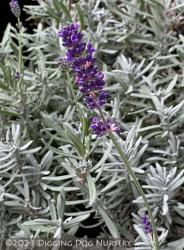
Arising from a meticulous breeding program in The Netherlands, this recent, lavishly hued introduction headlines dense, dark violet-blue flowers on short sturdy stems plus one of the most petite, close-knit habits available. Redolent pewter-green foliage shapes the neat valiant mound beneath a show-stopping, summer-long floral profusion. Undeterred by heat, air pollution, 4-legged visitors, winter cold and dry conditions, ‘Super Blue’ makes an all-purpose small-sized addition to knot, kitchen and pollinator gardens. It can also be hedged, grouped or planted as an edging. (pp#24,929)
Blooms June–August
Size: 10" – 12" high x 10" – 12" wide.
Hardy to zone 5.
First spotted by Kiwis Elsie and Brian Hall as a markedly unique seedling in a bed of Lavandula angustifolia 'Hidcote', 'Thumbelina Leigh' is distinctive for its compact spherical habit and short sturdy well-branched flower wands, offering a vibrant highly aromatic profusion of dense two-toned blooms. The sweet smelling rounded blossoms feature deep purple pubescent calyxes plus large corollas, colored both a bright violet-blue and dark lavender-violet. A stellar addition to path edges, the rockery, knot gardens and containers, the small impeccably formed gray-green mound celebrates a flowery encore if you shear one-third of its mass after the first bloom.
Blooms July–August.
Size: 12" – 15" high x 12" – 15" wide.
Hardy to zone 5.
Lavandula angustifolia ‘Victorian Amethyst’ (S-0693)
OUT OF PRODUCTION AT THIS TIME
Email me when this plant is available
As opulent as the gemstone, this English Lavender shimmers with amethyst-colored corollas set off by dark purple calyxes. Its winsome habit features a compact mass of young greenish gray leaves maturing to frosted silver, while the pretty blooms perched on short flowering stems bestow a soft old-fashioned feel.
Blooms June – July.
Size: 2' 0" high x 2-1/2' wide.
Hardy to zone 5.
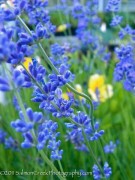
Bred by New Zealand Lavender authority Virginia McNaughton, this aptly named colorful cultivar delivers ultrascented, brilliant violet corollas and saturated violet-blue calyces on firm, long straight stems that are ideal for cutting. Silvery-green leaves dress its upright shapely stance, and with Artemisia ‘Sea Foam’, Horehound and Veronica ‘Pure Silver’ nearby, they craft a sparkling association. (pp#15,344)
Blooms June–July
Size: 2-1/2' high x 2-1/2' wide.
Hardy to zone 5.
Each $11.75
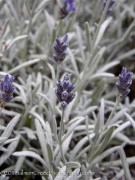
‘England’ is prized for its almost-miniature profile and downy silver foliage that hosts light violet-blue flowers at the height of summer. Easily tucked into a small garden or a tight nook, this irresistible Lavender can be partnered with Cistus ‘Tania Compton’.
Blooms July–September
Size: 12" high x 15" wide.
Hardy to zone 6.
Arising as a chance seedling between Lavandula lanata and Lavandula dentata at Jim and Dotti Becker’s Goodwin Creek Gardens in Oregon, this winsome strong-growing hybrid hosts slim lanky leaves with distinctive irregular toothed margins and a woolly whitish gray finish. The compact soft-looking ensemble emits a pleasant earthy whiff beneath long and slender, dense florescent violet-blue spikes that unfurl nearly year-round where winters are mild. More tolerant of heat and humidity than most Lavenders, but not as cold hardy, long-lived ‘Goodwin Creek Gray’ tempts hummingbirds, butterflies, honey bees and bumble bees plus offers striking contrast amid water-wise chums like Bupleurum or Phlomis samia.
Blooms June–October
Size: 2' 0" – 3' 0" high x 2' 0" – 3' 0" wide.
Zone 7b/8.
This distinctive Lavender affords pure white flowers plus a pleasing green and pewter-hued stature that’s somewhat smaller than our other intermedia cultivars. Soft-looking linear-shaped leaves clothe a compact form beneath subtly pink-blushed buds and sweet-smelling pearly-hued flower heads. A stellar candidate for slopes, gravel gardens, Mediterranean plantings and mixed borders, ‘Edelweiss’ celebrates a stalwart no-fuss temperament, electrifying scents and sparkling classy blooms, bewitching droves of pollinators and plant purveyors alike.
Blooms June–October
Size: 3' 0" high x 3' 0" wide.
Hardy to zone 6.
Lavandula x intermedia ‘Exceptional’ (S-0890)
Each $11.75
Developed at Hillier, an esteemed British nursery since 1864, this newly introduced Lavandula ‘Phenomenal’ sport is lauded for its long-blooming pearl-colored spires plus impeccable well-branched habit, promoting vigorous resilience and redolent allure. Chic frosty green foliage attires the snug fine textured mound that upholds a glimmering pollinator haven of copious white flowers with green calyxes on long sturdy stems. Undaunted by winter cold, drought and hot sun, ‘Exceptional’ lends incandescent highlights to patio containers, water-wise plantings, stone walls, dried creations and fellow Mediterraneans such as Rosmarinus ‘Lady in White’ and Eryngium ‘White Glitter’. (PPAF)
Blooms June–October
Size: 2-1/2' – 3' 0" high x 3' 0" – 4' 0" wide.
Hardy to zone 5.
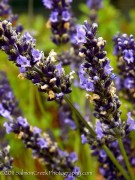
An enormously popular newcomer from Sault, France, this sensational dark flowering enchantress is destined to give ‘Grosso’ a run for its money. Perhaps the deepest colored lavender and an ideal candidate for fresh or dried bouquets, ‘Gros Bleu’ flaunts 4 in. long, slender tapering bloom spikes, described by dark purple woolly calyxes, deeply saturated violet corollas and a scent that’s sweeter than ‘Grosso’s, on exceptionally tall branched stems.
The good-sized robust mound of winsome, densely arranged greenish gray foliage makes a welcome addition to any landscape or commercial Lavender endeavor.
Blooms June – October.
Size: 3' 0" – 3-1/2' high x 3' 0" wide.
Zone 5/6.
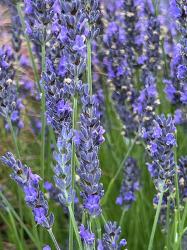

One of the fattest budded Lavenders, ‘Grosso’ entertains large purple-violet spikes above a rounded ash-green foundation that grows tight and tidy throughout the year, appearing like its just been trimmed. This aromatic Lavender is a choice candidate for mass plantings or a water-thrifty garden with cohorts such as Rockrose or Rosemary.
Blooms June–October
Size: 3' 0" – 3-1/2' high x 3' 0" wide.
Hardy to zone 6.
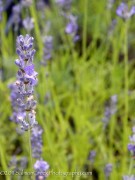
We first saw this dazzling English cultivar at the Norfolk Lavender Farm near Britain’s North Sea. ‘Hidcote Giant’ bears multitudes of large squat dark buds and sizable blue-violet flowers with lilac-green calyxes atop long elegant stems. Pair with Kniphofia ‘Safranvogel’ for glowing complementary bloom color.
Blooms June–September.
Size: 2-1/2' – 3' 0" high x 3' 0" wide.
Hardy to zone 6.
Cultivated by the renown British nursery, Hopleys in the early 1990s, this bushy Lavender strikes a hard-to-miss stance as dashing gray flanneled leaves closely line its large upright frame. Blue-tipped green buds give way to long, slender conical heads composed of fuzzy dark bluish calyxes and deep mauve-violet flowers. With such inherent good looks, ‘Lullingstone Castle’ makes a stellar hedge or a centerpiece amid fellow Mediterraneans in a dry area.
Blooms June – September.
Size: 2-1/2' – 3' 0" high x 3' 0" wide.
Hardy to zone 6.
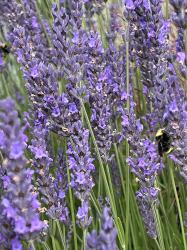
This remarkable 2012 introduction from Peace Tree Farms is being touted as one of the best Lavenders on the market after undergoing extensive trials throughout the country. A Lavandula ‘Grosso’ offspring, it’s large, uniform habit exhibits exceptional winter hardiness, an impressive ability to withstand heat and humidity plus excellent disease resistance. Symmetrically arranged, staunch upright stems cloaked in attractive silver-green foliage bolster a fragrant array of 5 in. long rich blue-violet spikes atop lengthy flower stalks. Splendid in fresh or dried arrangements, ‘Phenomenal’ can be hedged or added to perennial borders and Mediterranean plantings, while its heavily scented leaves and blooms produce high quality oil and culinary seasonings. (PPAF)
Blooms June–October
Size: 2-1/2' – 3' 0" high x 3' 0" – 4' 0" wide.
Hardy to zone 5.
Easily drawing your eye when planted in a drift and absolutely stunning by the hundreds in a field, a surplus of large violet flowers graces fine textured gray-green foliage. This topnotch cultivar’s neat, good-sized mound is long-lived and stays dapper all year, associating well with Kniphofia ‘Gladness’, Heuchera ‘Old La Rochette’ and Yarrows.
Blooms June – October.
Size: 3' 0" – 3-1/2' high x 3' 0" wide.
Hardy to zone 6.
The flowers of this cultivar possess an especially delightful aroma, and most closely resemble the fragrance of their angustifolia parentage. Considered by some to be one of the best intermedias for quality essential oil, ‘Super’ has tall, graceful stems, tapered buds, light violet-green calyxes, and large elongated flower heads, lighter colored than those of ‘Grosso’.
Blooms June–September.
Size: 3' 0" high x 3' 0" wide.
Hardy to zone 6.
Lavandula x intermedia ‘White Spikes’ (S-0259)
Each $11.75
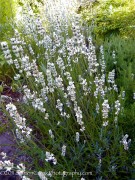
Creating subtle soothing accents, slender silver-laced green leaves and ample-sized aromatic flowers with bright white petals plus sage-green bracts crest firm tall stems. ‘White Spikes’s sophisticated bushy mound can be situated amid Lychnis coronaria ‘Alba’ and Calamintha ‘Montrose White’ for a gentle blend of white and pearly gray.
Blooms June–October
Size: 2-1/2' high x 2-1/2' wide.
Hardy to zone 6.
Introduced in 1991 by Ken Montgomery of Anderson Valley Nursery and named after his daughter, this hybrid between Lavandula angustifolia ‘Martha Roderick’ and Lavandula lanata retains the best qualities of both its parents. Like ‘Martha Roderick’, it is exquisitely compact, and like Lavandula lanata, its leaves are alluringly silver and downy. The frosted gray buds unfurl blue-violet blooms that make a compelling union with Geum ‘Georgenberg’ or Teucrium chamaedrys.
Blooms June–September
Size: 18" high x 2' 0" wide.
Hardy to zone 6.
Lavandula ‘Richard Gray’ (S-0329)
Each $11.75
With the hardiness of its angustifolia parentage and the soft-looking leaves of a lanata, ‘Richard Gray’ is a choice hybrid which bears medium blue-violet flowers on stems just a foot above the attractive, compact mound of silver-gray foliage.
Blooms July–August.
Size: 2' 0" high x 20" wide.
Hardy to zone 5.
Lavandula ‘Silver Frost’ (S-0608)
Each $11.75
Etched in frosted winter whites, this alluring angustifolia and lanata descendent is perhaps the most effulgent silver-foliaged lavender we offer. Its dense, downy soft mound supports a profusion of plump flowers heads with dark purple corollas and snowy violet-blue calyxes. A Van Hevelingen Nursery introduction, ‘Silver Frost’s good-sized form conveys an uplifting brilliance to the landscape at any time of year.
Blooms July–August.
Size: 2' 0" – 2-1/2' high x 2' 0" wide.
Hardy to zone 6.
Lavandula stoechas ‘Helmsdale’ (S-0814)
Each $11.75
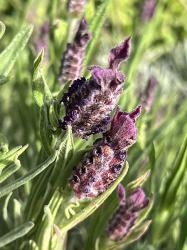
Developed by Marshwood Gardens in New Zealand, this stellar Lavandula stoechas pedunculata and Lavandula viridis hybrid is considered the best dark flow- ered stoechas cultivar in the trade. Whimsical looking rich burgundy bracts plus plump prismatic flowers splashed with vivid navy, violet and wine hues make a stunning juxtaposition against the aromatic, slender upright pale green foliage. Relishing winter protection around 0° and periodic shearing, ‘Helmsdale’s shrubby, robust, yet close-knit habit and plush flowers, which appear in droves from spring ’til fall, can dwell atop a sunny stone wall or in a dry well-drained herb garden.
Blooms April–August
Size: 2-1/2' high x 2-1/2' wide.
Zone 7a.

Crowned in a creamy white, this head turning Lavender originated as a hybrid seedling from Oregon’s Van Hevelingen Nursery. Large chubby flower heads house rows of small purple corollas beneath perky rabbit ear-like bracts, while pine-scented gray-green leaves fashion a neat pastel-colored base. Try mixing ‘Ivory Crown’ with Thymus ‘Albus’ and Eryngium ‘Silver Salentino’ for a luminous blend of white blossoms.
Blooms April – August.
Size: 2-1/2' high x 2-1/2' wide.
Zone 7/8.
Plump long-blooming dark blue flowers topped with luminous white rabbit ear-like tufts accord 'Madrid Blue' a whimsical air, while strongly scented narrow gray-green leaves fashion a compact tailored foil for the bevy of eye-catching aromatic blooms. Not as cold-hardy as other Lavandula species, this new cultivar needs a yearly trim, protection from harsh winter conditions and a well-drained locale to ensure its longevity and innate good looks.
Blooms April–August.
Size: 18" – 2' 0" high x 18" – 2' 0" wide.
Hardy to zone 7.
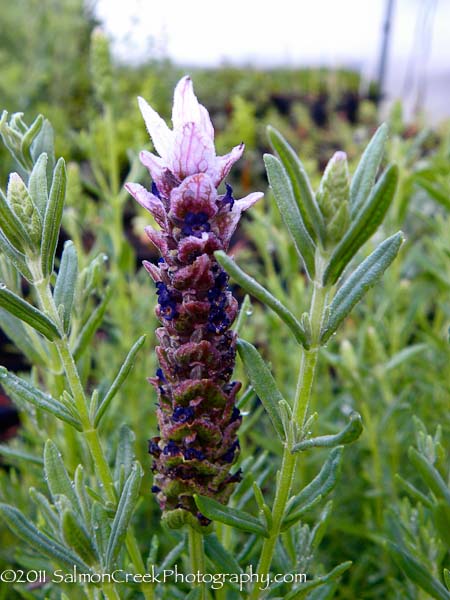
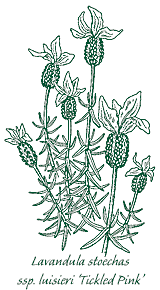
It’s hard to feel anything other than tickled pink by the pretty showing of large, frilly pink bracts that gather in prominent tufts atop plump egg-shaped, dark plum-colored flowers. A compact and well-groomed bushy shrub, ‘Tickled Pink’s aromatic sage-green leaves are graced by a splendid repeat bloom come autumn.
Blooms April – August.
Size: 2-1/2' high x 2-1/2' wide.
Zone 7/8.
Lavandula stoechas ‘Willow Vale’ (S-0282)
Each $11.75
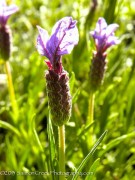
Introduced by David Tristram of England, this vigorous Lavender is named for its wispy gray-green foliage, which creates a delicate veil over the strong, upright branches. The showy deep blue-violet flowers are crowned with a tuft of purple petal-like bracts, and bloom earlier than the intermedia varieties.
Blooms April–August
Size: 2-1/2' high x 2-1/2' wide.
Hardy to zone 7.
OUT OF PRODUCTION AT THIS TIME
Email me when this plant is available

A virtual stranger to American gardens, this dainty sweetly scented little shrub delivers flowers in a big way! Easily mistaken for a miniature Lilac, L. oblonga debuts small starry lavender pink blooms, blanketing a compact low-to-the-ground mound of tidy medium green foliage in spring and intermittently through early autumn. With a delicately textured diminutive aspect that belies its ability to tackle pests, poor soil and drought, once established, this long blooming northern Chinese gem will colorfully perfume a walkway, a front row seat in the mixed border or even a container.
Blooms May–June
Size: 12" – 18" high x 18" – 2' 0" wide.
Hardy to zone 5.
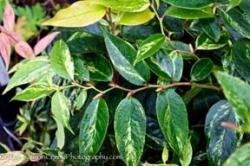
An elegant arching Pieris relative, this elaborately variegated cultivar originated at the famed British nursery, Hillier's as a chance seedling, while the species, first introduced in 1793, hails from the southeastern U.S. Living up to its name, 'Rainbow' celebrates a carousel of color: pinkish copper-hued new growth, rosy red stems and long leathery pointed evergreen leaves, which are irregularly streaked, speckled and mottled in green, cream and ivory. Bell-style crisp white flowers held by drooping clusters, blue berries and plum-colored wintertime foliage are the icing on the cake. Appreciative of regular watering and well-drained organic-rich acidic soil, the deer resistant Fetterbush makes a stunning focal point or mass planting, embellishing mixed borders, house foundations, hedges and even cut arrangements.
Blooms April – May
Size: 3' 0" – 4' 0" high x 4' 0" – 6' 0" wide.
Hardy to zone 5.
Leycesteria
Himalayan Honeysuckle
Cherished by birds and gardeners alike, these deciduous, hollow-stemmed Himalayan shrubs bestow a long lasting floral and berry spectacle that extends until frost. Undemanding in any fertile soil, Leycesteria’s tall stalks appreciate an extra thick layer of winter mulch in colder climates, where they may die to the ground, but will rapidly leap skyward in the spring.
Each $12.25
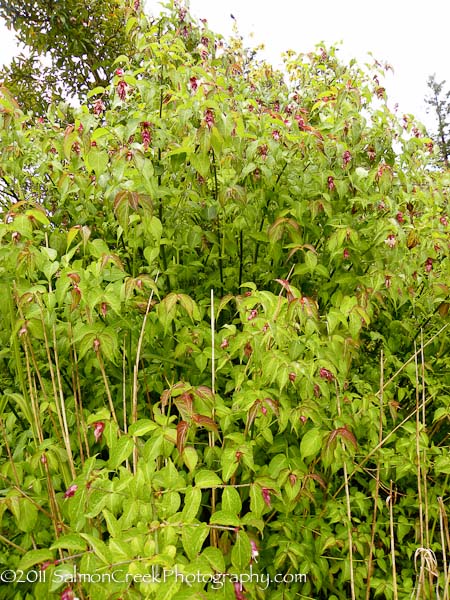
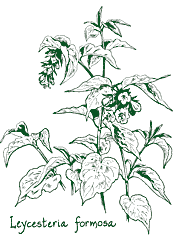
This Nepalese woodland shrub is adorned first with clusters of white-tipped, tubular pink flowers surrounded by beet-red bracts. Cherished by birds and gardeners alike, its fruit later matures into shiny chocolate-brown berries that taste like caramel-flavored raisins. Pointed, heart-shaped leaves extend stiffly from bamboo-like, hollow sea-green stems. We plant it as a specimen next to walkways so that we can enjoy the colorful details. Undemanding in any fertile soil, Leycesteria’s tall stalks appreciate an extra thick layer of winter mulch in colder climates, where they may die to the ground, but will rapidly leap skyward in the spring.
Blooms late July–October
Size: 6' 0" high x 4' 0" wide.
Zone 6/7.
Leycesteria formosa ‘Golden Lanterns’ (S-0609)
Each $13.25
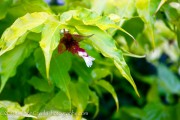
A newly introduced English cultivar, ‘Golden Lanterns’ has the same tantalizing attributes as the species but with an illuminated twist. Dark burgundy bracts and berries become intriguing counterpoints to amber-tinted new growth and the lambent yellow-green foliage that promises to brighten your daytime, or even moonlight garden stroll. (PPAF).
Blooms late July–October.
Size: 4' 0" – 6' 0" high x 4' 0" wide.
Zone 6/7.
Ligustrum
Privet
Ligustrum sinense ‘Pendulum’ (S-0674)
OUT OF PRODUCTION AT THIS TIME
Email me when this plant is available
Reviving the summertime garden when few other shrubs are blooming, its sweet-scented, frothy white terminal sprays cascade against a polished, dark green deciduous foil. This tidy well behaved cultivar is non-invasive unlike the species and is characterized by gracefully weeping side branches, clothed with slender, ovate paired leaves.
A tranquil placeholder in the mixed border, easily grown ‘Pendulum’ obliges sun or shade and produces abundant blackish purple fruit, enhancing ornamental appeal and furnishing food for the birds.
Blooms July – August.
Size: 6' 0" high x 6' 0" – 8' 0" wide.
Hardy to zone 6.
Magnolia
Formerly Michelia
OUT OF PRODUCTION AT THIS TIME
Email me when this plant is available
A denizen of southwestern China’s forested mountains and thickets, this handsome evergreen hosts fuzzy cinnamon-colored buds plus plentiful 2 in. wide chalice-shaped creamy-white flowers defined by overlapping petals, bold sun-kissed stamens and a lavish fragrance that’s added to perfumes. The posh blooms, each nestled in a leaf axil, illuminate lustrous dark green foliage with velvety bronze-haired flip sides. Developing into an undemanding large shrub or diminutive tree, Magnolia laevifolia can be utilized as a screen, textural hedge, topiary subject or mixed border specimen, where it readily responds to pruning, obliges a clip after flowering and relishes evenly-moist slightly-acidic alcoves.
Blooms March–May
Size: 10' 0" – 12' 0" high x 10' 0" – 12' 0" wide.
Hardy to zone 8.
Magnolia laevifolia ‘Free Spirit’ (S-0812)
OUT OF PRODUCTION AT THIS TIME
Email me when this plant is available
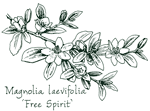
Unparalleled among its relations, this recently available exciting evergreen cultivar was discovered as a naturally occurring hybrid in Lytterton, New Zealand. The unique low growing branches craft a horizontally spreading frame attired with handsome polished leathery leaves and a downy-soft, deep copper-hued pubescence that promotes cozy warm accents. Held in an upward-facing fashion, the posh, ambrosial spring-time flowers arrive in long lasting pure white droves and sometimes offer a fall encore. ‘Free Spirit’ effortlessly charms a container, stone wall, slope or patio, savoring well-drained soil, bright dappled shade and shelter from extreme cold. (pp#24,534)
Blooms April–June
Size: 18" – 2' 0" high x 6' 0" – 8' 0" wide.
Zone 7/8.
OUT OF PRODUCTION AT THIS TIME
Email me when this plant is available

A 1980 British introduction by noted plantsman Roy Lancaster, this rare, widely praised Chinese native features dapper dark green leaves, flashing bright white undersides and dainty reddish pink cupped flowers with creamy yellow centers. Poised in airy splendor on lax slender racemes, the eye-catching blooms precede a plentiful display of large, bloomy blue-black fruit.
Mahonia gracilipes is a stellar and sturdy, slow growing evergreen, which favors partial shade in moist welldrained, humus-rich soil.
Blooms August – November.
Size: 4' 0" – 5' 0" high x 4' 0" – 5' 0" wide.
Hardy to zone 7.
Mahonia x media ‘Charity’ (S-0659)
OUT OF PRODUCTION AT THIS TIME
Email me when this plant is available
Guaranteed to chase away those wintertime doldrums, ‘Charity’ spotlights an ebullient fountain of small, bell-shaped canary yellow flowers. The grandiose leaves—pinnate, spiny and matt green—grow in magnificent whorls along coarsely branched stems while arching, sweet scented racemes burst forth above. Waxy, late summer berries held in grapelike bluish purple clusters are relished by birds and spark our interest for another season.
Stellar as a statuesque specimen all year long, this upstanding evergreen develops an imposing vase figure that tolerates heavy clay, flourishes with a little shade on a loamy, well drained somewhat acidic site, and can be pruned back after flowering.
Blooms late November–February.
Size: 7' 0" – 10' 0" high x 4' 0" – 5' 0" wide.
Hardy to zone 7.
Each $14.75
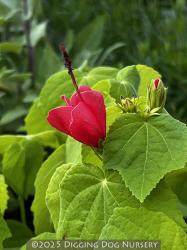
An old-fashioned southern “pass-along” plant, this grand long flowering shrub is endemic to the southeastern U.S., Mexico and Central America. Hummingbirds, butterflies, birds and bees swoon over its unique vermilion blooms whose overlapping petals resemble a turban, while hibiscus-style, brilliant red floral tubes jut beyond. The fanciful fringed green buds and vivacious flowers appear from summer through autumn, adorning an undemanding open visage of fuzzy stiff upright stems, long petioles and lobed, heart-shaped flannel-like green leaves. Turk’s Turban grows as a large deer- resistant evergreen in mild winter areas, makes an admirable, dense small-sized hedge with regular pruning and relishes moderate water plus shelter around 20°.
Blooms June–October
Size: 4' 0" – 10' 0" high x 4' 0" – 10' 0" wide.
Zone 8b/9.
Michelia ‘Inspiration’ (S-0779)
OUT OF PRODUCTION AT THIS TIME
Email me when this plant is available
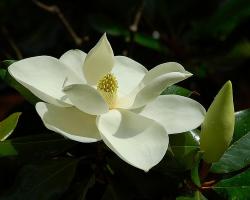
Exquisitely sculpted and lavishly fragrant, the large creamy white flowers of this southern Chinese, Magnolia- related beauty, promise to inspire. Unfurling from furry, milk chocolate-colored buds that form in the leaf axils, rounded blooms host overlapping petals and bold sun-kissed stamens amid lustrous leathery dark green leaves cloaked with velvet-soft brown hairs on the flipsides. Named after Pietro Micheli, a 17th century Italian botanist, densely set Michelia 'Inspiration' is vertically oriented and shorter than the species, thus perfectly sized for a more intimate setting, especially near sheltered patios or pathways. Adequate mulch and slightly acidic, moisture retentive soil maintains its alluring grandeur. (PPAF)
Blooms April – June.
Size: 8' 0" – 10' 0" high x 4' 0" – 5' 0" wide.
Hardy to zone 8.
Paeonia
Tree Peony
These shrubby undemanding Paeonias combine winning foliage with ultra-chic flowers. Prospering in average garden soil that's either acidic or alkaline, but not overly wet, they enjoy a periodic pruning and protection from spring frost.
OUT OF PRODUCTION AT THIS TIME
Email me when this plant is available

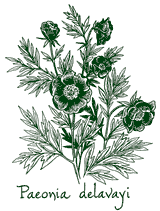
Named after Pierre Jean Marie Delavay, a French missionary and avid plant collector who resided in China during the late 1800s, this gorgeous, rarely cultivated Peony showcases lavish burgundy blossoms amid splendid foliage. The slightly nodding, dark shiny flowers are fragrant and brightened by a large central cluster of yellow stamens. Strong, red-tinted upright stems and deciduous, deeply cut glaucous green leaves sculpt an undemanding, long-lived elegant shrub.
The Maroon Tree Peony handles spring frosts, needs a pruning to maintain its bushy habit and appreciates a cool, moist sheltered site with a generous helping of well rotted manure.
Blooms May.
Size: 5' 0" – 6' 0" high x 2' 0" – 3' 0" wide.
Hardy to zone 6.
Paeonia delavayi var. lutea (S-0815)
OUT OF PRODUCTION AT THIS TIME
Email me when this plant is available
This distinctive fine textured Tree Paeonia achieves four-season panache. Cup-shaped, fragrant and crimpled, the swank 2 to 3 in. lemon-yellow flowers dress a lush lacy looking foundation. The large deciduous light green leaves are deeply segmented, beaming bright yellow fall colors, while orange-red seed pods heighten late season intrigue and thickened stalks spark arresting winter architecture. Seriously endangered in China due to over-collecting for medicinal purposes, Paeonia delavayi var. lutea makes a superb specimen in an herbaceous border where it favors good drainage and dappled light.
Blooms May–June
Size: 6' 0" – 8' 0" high x 4' 0" – 5' 0" wide.
Hardy to zone 6.
OUT OF PRODUCTION AT THIS TIME
Email me when this plant is available

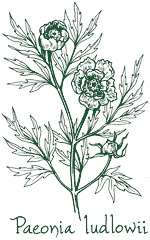
This long-lived woody Peony offers a reliable spring showing of big saucer-shaped golden yellow flowers with sumptuous chiffon-style petals and decorative fringe-like stamens. Sturdy upright stems produce magnificent large green deciduous leaves, defined by deeply carved leaflets, contrasting pink petioles and sunshine-colored autumn shades. Easily grown, hardy and relatively pest-free, P. ludlowii promises an imposing stance whether planted as a hedge or exquisite specimen, along walls and pathways or in mixed borders. Tibetan Tree Peony wards off deer, welcomes shelter from the wind, prefers well-drained soil and requires minimal pruning.
Blooms May–June
Size: 7' 0" – 8' 0" high x 2' 0" – 2-1/2' wide.
Hardy to zone 5.
Paeonia ostii ‘Phoenix White’ (S-0807)
OUT OF PRODUCTION AT THIS TIME
Email me when this plant is available
Heightened by seductive dark red centers and furry yellow stamens, large upward facing flowers with crinkled silken white petals promise a lavish floral feast for gardeners and bees. The densely fragrant wide-open blooms, occasionally laced with pink veins, appear to float upon glossy lobed dark green leaves and stout woody stems, crafting a noble addition to any garden. Early flowers, deer resistance and intriguing winter architecture are the hallmark of this easily maintained, fast growing vigorous shrub, which cherishes light shade, conservative pruning and moist well-drained moderately fertile sites.
Blooms May–June
Size: 3' 0" – 4' 0" high x 2-1/2' wide.
Hardy to zone 5.
Parahebe catarractae (lavender form) (S-0122)
Each $13.00
-585.jpg)
After just one close glance at its dainty upright clusters of petite, lilac-hued flowers set off by magenta-streaked petals and white and crimson centers, you’ll find this adorable plant hard to resist. Small oval leaves, lustrous and prominently toothed, neatly line wine-hued stems, fashioning a dwarf low spreading mound that can be situated amid Heuchera ‘Weston Pink’ and Geranium ‘Melinda’.
Blooms June – September
Size: 12" high x 2' 0" wide.
Hardy to zone 8.
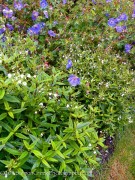
Graham Stuart Thomas referred to the Parahebes as ‘little treasures’, and once you get to know this charming New Zealand native you’ll see why. Forming an easygoing, dense semishrubby plant, princely pairs of serrated deep green leaves, polished and narrow, extend from reddish stems that respond well to pruning. Unbelievably profuse and long blooming, the tiny, white cupped flowers are a study in delicacy, each with a green eye and magenta ring, while populating loosely arranged terminal clusters.
Roses, Geranium ‘Orion’ and Hydrangea ‘Enziandom’ spill over an unshorn evergreen hedge of Parahebe linifolia in our garden for a flowery summer time gala.
Blooms June – October
Size: 18" – 2' 0" high x 2' 0" wide.
Hardy to zone 8.
Philadelphus
Mock Orange
First introduced to Europe along with Lilacs by Ambassador Ogier Ghiselin de Busbecq in 1562, this timeless and easy-to-grow hollow-branched shrub was used by the Turks to make pipes. Its Latin name means “brotherly love” and its orange blossom-like fragrance has enhanced teas, perfumes, and almost certainly, many friends’ walks in the garden.
Philadelphus coronarius ‘Aureus’ (S-0128)
OUT OF PRODUCTION AT THIS TIME
Email me when this plant is available
A denizen of southern Europe and Asia Minor, this sublime, upright, medium-sized shrub steals the show as vibrant, oval-shaped gold leaves burst forth in spring. Citrus-scented, 2 in. wide, crisp white flowers bestow additional enticements, while the deciduous leaves adopt refreshing lime-green hues by midsummer. Acquiring a British AGM plus popularity among pollinators and gardener’s alike, ‘Aureus’s bushy glowing habit relishes a sunny abode with moderate water and protection from hot afternoon sun.
Blooms May–June
Size: 5' 0" – 6' 0" high x 4' 0" wide.
Hardy to zone 5.
Philadelphus ‘Innocence’ (S-0613)
OUT OF PRODUCTION AT THIS TIME
Email me when this plant is available
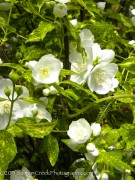
We like to inhale the intoxicating orange sweetness given up by these freely borne, pure white blossoms that openly welcome. Gathered at branch tips, the large 4-petaled flowers garnish ovate green leaves randomly splashed and streaked with creamy whites, yellows and golds. A courtly perfumed scene stealer, this 1900s Lemoine Nursery cross between Philadelphus microphyllus and Philadelphus coronarius matures into an imposing shrub with fluid, arching branches.
Blooms June
Size: 8' 0" – 10' 0" high x 8' 0" wide.
Hardy to zone 5.
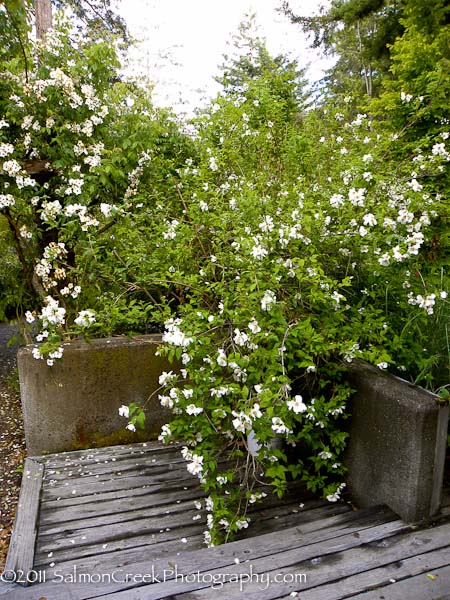
Its name conjures thoughts of beautiful stars (Belle Etoile). Tinged red at the base of each of the four petals, the white flowers explode like fireworks just when spring-blooming shrubs are finishing their display. In close proximity to an entrance or walkway amid Luzula ‘Auslese’ and Geranium ‘Ingwersen’s Variety’, this artful shrub is deliciously fragrant and unmistakably choice.
Blooms June–August
Size: 6' 0" – 8' 0" high x 6' 0" wide.
Hardy to zone 5.
Collected during Lewis and Clark’s 1806 expedition, this delightful native’s habitat extends from British Columbia to California and east to Idaho and Montana. A bonanza of clustered 4-petaled, 2 in. wide pure white blossoms debuts dense radiant yellow stamens and a fresh fruity citrus scent, enticing bees, butterflies, hummingbirds and gardeners. Cloaked in paired ovate bright green leaves with prominent veins and paler undersides, numerous strong erect arching stems forge a large loosely-branched vase-like silhouette. Lewis’ Mock Orange can be featured by a pathway and as an amenable deciduous specimen in a mixed border, native planting or informal hedge, where it affords yellow fall color, develops flaky gray bark and withstands full sun, partial shade plus periodic dry conditions.
Blooms June–July
Size: 5' 0" – 8' 0" high x 5' 0" wide.
Hardy to zone 4.
Philadelphus mexicanus ‘Plena’ (S-0245)
Each $16.50
Of all our selections, this one smells the sweetest. The elegant cream-colored double flowers are bowl-shaped and the green foliage remains glossy and crisp even under stress from heat and sun. Ours grows at the base of an apple tree,constantly tempting us to put aside work for awhile and linger in its scent.
Blooms August–October
Size: 5' 0" – 6' 0" high x 5' 0" – 6' 0" wide.
Hardy to zone 9.
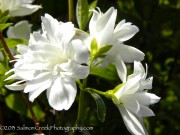
If space is a premium in your garden and you’re searching for an ambrosial delight, you may want to try this short-sized, winter-rugged Canadian beauty. Oval-shaped dark green leaves and upright arching stems craft a dense foil for the abundance of exquisite crisp white flowers. With its neat dwarf appearance and fragrant summer blossoms, ‘Snow Dwarf’ can be featured as a container specimen or positioned close to the frontlines.
Blooms May–June
Size: 2' 0" – 3' 0" high x 2' 0" – 3' 0" wide.
Hardy to zone 4.

Gorgeous terminal clusters of double snowy-white blossoms ring in summer, filling the air with zesty citrus aromas. The amazing floral profusion promises a timeless elegance whether it’s gracing ‘Snowbelle’s diminutive deep green foliage, the bouquets of a June wedding or a vase on your table. Small enough for a garden pot or for flanking a pathway, this handsome, low growing Canadian cultivar exhibits a tidy compact profile plus superb heat and cold tolerance.
Blooms May–June
Size: 4' 0" high x 4' 0" wide.
Hardy to zone 4.
Philadelphus ‘Starbright’ (S-0764)
OUT OF PRODUCTION AT THIS TIME
Email me when this plant is available
A stellar gathering of newly emerging leaves infused with bronze and purple hues and large single white sterile flowers exquisitely cradled by dark purple calyxes are this hybrid’s distinctive signature. Recently developed at the Memorial University Botanical Garden in Newfoundland by Dr. Wilf Nicholls, ‘Starbright’ inherits Philadelphus delavayi’s classy perfumed blooms and the dogged constitution of Canadian born, Philadelphus lewisii, which withstands drought, deer and cold. Its appealing dense upright frame can be successfully segued into mixed plantings, either massed or as a stand-alone specimen. (pp#18,651)
Blooms June–July
Size: 8' 0" – 9' 0" high x 6' 0" wide.
Hardy to zone 3.
Philadelphus x ‘White Rock’ (S-0793)
OUT OF PRODUCTION AT THIS TIME
Email me when this plant is available
Pure white semidouble blossoms create a delightful passage, ushering the last days of spring into summer’s warm embrace. Distinguished by a lovely orange scent, the pearly-hued profusion of large, cut flower-perfect blooms nearly envelopes ‘White Rock’s pleasing rounded habit. Appreciative of bright, somewhat moist, well-drained sites and a trim once the flowers are spent, this Philadelphus beckons us when in bloom, while its deciduous rich green foliage maintains a tailored appearance throughout the season.
Blooms May–June
Size: 4' 0" – 6' 0" high x 5' 0" – 7' 0" wide.
Hardy to zone 4.
x Phylliopsis ‘Sugar Plum’ (S-0748)
OUT OF PRODUCTION AT THIS TIME
Email me when this plant is available

Conjuring visions of dancing fairies, this enchanting Ericaceous gem is an intergeneric hybrid between Phyllodoce and Kalmiopsis, conceived at Hillier’s in the 1980s. Dainty deep pink urns nearly envelop a tidy low evergreen mound of compact dark green Heather-like foliage. With reddish stems and calyxes, ‘Sugar Plum’ offers a flowery summer encore, prospers in well-drained acidic soil and looks simply irresistible in the rockery, alpine garden or a treasured container.
Blooms May–June
Size: 6' 0" – 10' 0" high x 12" – 2' 0" wide.
Hardy to zone 5.
Physocarpus
Common Ninebark
Anywhere eye catching foliar masses are needed, the following deciduous selections can fill the bill. With a leafy, casual look, Physocarpus presents three-lobed leaves, distinctive corymbs of tightly clustered small flowers and earthy red pillow-shaped fruit along their stems. These cold tolerant, Spiraea and Neillia kin possess both a durable, yet alluring bent.
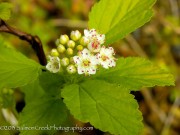
Named for its broad three-lobed golden spring foliage, which turns lime-green in the summer, this fine shrub is also notable for its wide arching branches with pink-dusted white flowers. The colors blend well with an understory of Geranium ‘Salome’ and Euphorbia x robbiae.
Blooms June–July.
Size: 6' 0" high x 6' 0" wide.
Hardy to zone 4.
For it’s versatile year-round appeal, this upright and arching multi-stemmed native shrub boasts an AGM plus the Gold Medal Award from Pennsylvania’s Horticultural Society. Discovered amongst a field of seedlings at Germany’s Kordes Nursery, ‘Diabolo’s lobed, Maple-like deep purple leaves turn dark green in shade or during hot summers, yet flash a sumptuous wine-colored fall finale. Dense rounded Spirea-like clusters of petite five-petaled pinkish white flowers are followed by bird-friendly, pendent red berries in fall, while winter reveals red and sable-infused exfoliating bark. Enduring drought and most soil types, the mighty, undemanding profile can be added to slopes for erosion control plus shrubby borders and woodland peripheries, either as a screen, en masse, hedged or as a specimen. Full sun and vigorous pruning ensures a handsome, opulently purple habit, especially when Buxus and Spiraea are planted nearby.
Blooms June–July
Size: 4' 0" – 8' 0" high x 4' 0" – 8' 0" wide.
Hardy to zone 4.
Physocarpus opulifolius ‘Mindia’ (S-0661)
OUT OF PRODUCTION AT THIS TIME
Email me when this plant is available
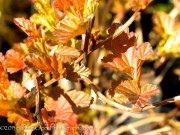
Copper-toned spring leaves distinguish this spectacular new cross between ‘Dart’s Gold’ and ‘Diabolo’, which was bred by Frenchman Jean Paul Divasse. As the weather warms, the foliage adopts a rich red, embellished with a summertime plethora of buttonlike pinkish white blooms and later, decorative scarlet seed heads. Winter reveals a dense, vigorous framework of attractive peeling bark, proving ‘Coppertina’ to be a shrub for all seasons. No special care required, easily hedged and indispensable as a specimen, it deserves a commanding position in your garden. (pp#16,371)
Blooms June–July
Size: 7' 0" – 9' 0" high x 8' 0" wide.
Hardy to zone 4.
Pieris
Japanese Andromeda
Pieris ‘Forest Flame’ (S-0635)
Each $17.75

Earning a coveted AGM, this superb large evergreen combines the hardiness of Pieris japonica with the blazing new growth of its other parent, Pieris ‘Wakehurst’. The young leaves present a prismatic carousel that ranges from flame-red to pink, then creamy white followed by a lustrous deep green. A chance seedling discovered in Britain’s Sunningdale Nursery around 1946, ‘Forest Flame’s slow-growing, dense upright habit beckons all year. Pendent, branched clusters of small bell-shaped white blooms herald early spring, while late summer headlines bead-like rose-colored flower buds. Tolerant of dark recesses, it enjoys dappled shade, adequately moist, somewhat acidic abodes plus protection from wind and afternoon sun.
Blooms March–April
Size: 4' 0" – 7' 0" high x 4' 0" – 7' 0" wide.
Hardy to zone 5.

The variegated darling for the rockery, a container or other cramped garden quarters, ‘Little Heath’ bestows a sprightly year-round textural presence. Enchanting, bell-like tiny white blooms, small slim leathery gray-green leaves with yellowish green margins and newly unfurled bronzy pink foliage distinguish this impeccable globe-shaped evergreen. Japanese Andromeda’s compact habit prefers adequate moisture, some afternoon shade and slightly acidic quick-draining soil.
Blooms March–April
Size: 2' 0" – 3' 0" high x 2' 0" – 3' 0" wide.
Hardy to zone 5.
Pieris japonica ‘Brookside Miniature’ (S-0840)
OUT OF PRODUCTION AT THIS TIME
Email me when this plant is available
The small-statured columnar profile of this tasteful, slow growing Pieris makes it unique. Initially emerging in vibrant chartreuse tones, pint-sized, glossy green leaves are held snugly against stiff upright stems, while urn-like, pristine white flowers populate myriad pendulous chains, tantalizing bees, hummingbirds and floral designers. An undemanding, tight set evergreen, ‘Brookside Miniature’ bestows winning year-round appeal to a patio vessel, the rockery, mixed borders, massed woodland plantings and gardens with limited space.
Blooms March–April
Size: 2' 0" – 4' 0" high x 2' 0" – 3' 0" wide.
Hardy to zone 6.
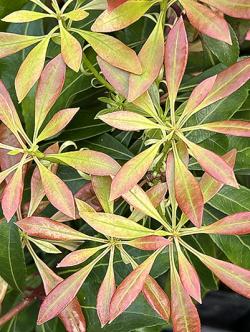
A luxurious bee-friendly cascade welcomes spring with large clusters of petite deep pink buds plus plentiful urn-shaped rose-pink flowers that don ivory-streaked rims and eventually fade to white. Extending the lovely display, ‘Valley Rose’s fine textured upright habit sprouts reddish copper-colored new growth against small glossy deep green mature leaves. First noted at Oregon’s Willamette Research Center by Dr. Ticknor, this sophisticated slow-growing evergreen shrub can be utilized as a compact rounded specimen or planted en masse in a mixed border. Somewhat acidic, evenly-moist well-drained enclaves bolster its easy-care disease resistant prowess.
Blooms March–April
Size: 4' 0" – 5' 0" high x 4' 0" – 5' 0" wide.
Zone 5b/6.
Pieris japonica ‘Variegata’ (S-0205)
Each $17.75
Potentilla
Shrubby Cinquefoil
Resilient and undemanding perennials cherished for their long-blooming season, tidy appearance and attractive foliage, Potentillas endure poor soil, but insist on good drainage.
Potentilla fruticosa ‘Apricot Whisper’ (S-0763)
Each $13.00

Delicate parchment-like 5-petaled flowers awash in hushed apricot-pink hues coupled with dainty tightly woven dark green leaves set this compact easily grown shrub apart. Promoting fine textured appeal, an attractive flourish of small narrowly divided foliage garbs the versatile twiggy habit that makes an excellent hardy choice for low hedges, foundations or mixed borders. ‘Apricot Whisper’ can handle sandy or gravel-strewn soil, but dislikes hot humid areas, and enjoys a midsummer trimming.
Blooms June–September
Size: 2' 0" – 3' 0" high x 2' 0" wide.
Hardy to zone 3.
Potentilla fruticosa ‘Limelight’ (S-0866)
Each $13.00
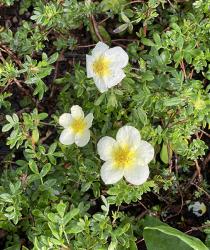
The sparkling flood of star-shaped creamy-white blooms amid a well-branched bushy habit earned this must-have Potentilla its epithet plus a coveted AGM. Winsome pinnate green leaves forge a close-knit deciduous foundation for the long-lasting lucent flowers, each hosting 5 rounded overlapping petals, which gradually deepen to canary-yellow at their bases. Undeterred by cold winters, poor soil and most insects, ‘Limelight’ adds a lively summer-long aspect to the rockery, cottage garden or the front of a mixed border.
Blooms June–September
Size: 2' 0" – 3' 0" high x 2' 0" – 3' 0" wide.
Zone 2/3.
Potentilla fruticosa ‘McKays White’ (S-0841)
Each $13.00
Hailing from Wisconsin’s McKay Nursery, this rounded upright shrub debuts delicate 5-petaled, creamy white blooms from early summer ’til autumn upon an attractive, fine-textured green foil of narrow elliptical leaflets. The long-lasting pearlescent flowers coupled with close-knit deciduous foliage impart a composed classic aspect that can embellish foundations, mixed borders or en masse plantings. Undaunted by deer, cold weather, varied soil types and dry conditions, easy-care ‘Mckay’s White’ dazzles pollinators, adopts yellow and cocoa hues for fall plus appreciates a hard, late winter cutback.
Blooms June–September
Size: 2' 0" – 3' 0" high x 2' 0" – 3' 0" wide.
Hardy to zone 2.
Potentilla fruticosa ‘Pink Beauty’ (S-0855)
Each $13.00
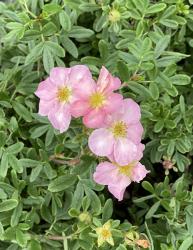
Hats off to the University of Manitoba for this tailored AGM recipient and its floriferous clear-pink display. Conjuring wild roses, the adorable pastel-hued blooms present sprightly yellow eyes encompassed by whitish centers amid small pinnate medium green leaves. ‘Pink Beauty’s mounding bushy habit emphasizes natty fine-textured accents, which can be juxtaposed against broad-leafed shrubs and perennials in courtyards, seashore plantings, cottage gardens or herbaceous borders.
Blooms June–September
Size: 2' 0" – 3' 0" high x 2' 0" – 3' 0" wide.
Zone 2/3.
A friend to bees, butterflies and gardeners alike, ‘Sunset’s dazzling galaxy of lucent rose-like brunt-orange blooms with fiery-red streaks and yellow highlights blazes through summer. Small trim deciduous green leaves plus closely woven branches distinguish this plucky fine textured shrub that’s tailor-made for mixed borders, low hedges or cottage gardens. Relishing occasional trimming, the long-lived habit conquers deer, cold winters and periodic drought.
Blooms June–September
Size: 2' 0" – 3' 0" high x 2' 0" – 3' 0" wide.
Hardy to zone 3.
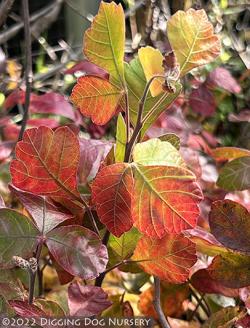
Hailing from Missouri’s glades and open woods, this tough-as-nails deciduous ground-hugger delivers tiny clustered yellow blooms amongst dense aromatic twigs with scented, glossy trifoliate leaves. Glowing red, orange and purple autumn foliage plus showy red berries provide additional enticements. Fragrant Sumac’s unflappable, fast growing persona stabilizes embankments, smothers weeds, abates erosion plus tackles clay and dry rocky soil. Adored by birds and butterflies, ‘Gro-Low’ is invaluable for difficult spots, naturalized settings, informal hedges and slopes.
Blooms April–May
Size: 18" – 2' 0" high x 6' 0" – 8' 0" wide.
Zone 3b/4.
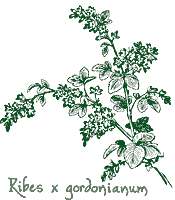
In Tudor times, to dream of the ripe fruit of a flowering currant was said to herald great fortune, many children and the accomplishment of your dreams. This choice woodland shrub is a vigorous and hardy cross between Ribes odoratum and Ribes sanguineum.
Its clusters of raspberry-red flowers, highlighted with creamy yellow throats, appear a salmon color at first glance and cascade gracefully amidst the lobed, toothed foliage. Plant atop a stone wall with an understory of Brunnera ‘Langtrees’, and watch the birds enjoy its black berries.
Blooms March
Size: 5' 0" high x 2' 0" – 3' 0" wide.
Hardy to zone 4.
Ribes sanguineum ‘King Edward VII’ (S-0749)
Each $16.75
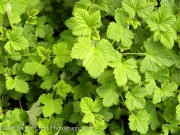
Adorned with pendulous late winter clusters of richly colored scarlet-red flowers, well-mannered bare arching branches spawn palmately lobed medium green leaves in early spring. Following the fantastic long-lasting floral pomp, persistent green and bright red berries, which ripen to a frosted dark blue, heighten summer appeal and come fall, urbane finely serrated foliage broadcasts lovely amber, pink and golden tones. Introduced into the annals of British horticulture in 1817, ‘King Edward VII’s narrowly upright and compact carriage is easily managed, plus it withstands drought once established and effortlessly dominates a sunny mixed border or a bright woodland realm.
Blooms mid-February–early May
Size: 6' 0" – 8' 0" high x 4' 0" – 5' 0" wide.
Hardy to zone 6.
Rosa
Rose
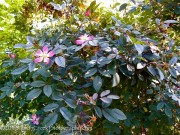
Celebrated for its dreamy, pewter-blue serrated foliage and the elegant simplicity of its single, light-centered, clear pink flowers, this princely shrub has a tranquil persona. Nearly thornless, medium-sized canes transmute purple hues, while offering quantities of shiny, oval-shaped coppery red hips that spice up the off-season landscape.
Indigenous to central and southern Europe’s mountains, Rosa glauca has been cultivated as a gracefully arching medium-sized specimen since the early 1800s and in our garden, it passes time alongside a silver-leafed Teucrium fruticans (Select Form).
Blooms June.
Size: 8' 0" high x 6' 0" wide.
Zone 2/3.
Rosmarinus
Rosemary
Studious Greeks twined Rosemary in their hair “for remembrance” before exams; the French burned it as an incense substitute in cathedrals. And of course, there’s the taste—pungent and aromatic, a pinch delivers a punch of flavor. The rugged evergreens of this genus afford short needle-like foliage studded with tiny, orchid-shaped mostly blue blooms. Rosemary obliges heat and poor soil, triumphs over deer and diseases, only improves with age and doesn’t demand much, except for sharp draining soil.
Rosmarinus officinalis ‘Arp’ (S-0060)
Each $12.00
That’s Arp, Texas, where one ol’ specimen is still growing strong at 80. An upright shrub with gray-green foliage and light blue flowers, ‘Arp’ is most at home inland, where it opens outward in the heat; on the coast its habit is more compact, but still handsome.
Blooms March–July.
Size: 3' 0" – 4' 0" high x 2' 0" wide.
Hardy to zone 8.
Rosmarinus officinalis ‘Blue Spires’ (S-0151)
Each $12.00
Touting a heady fragrance plus increased cold hardiness, ‘Blue Spire’s handsome foundation hosts tightknit upright branches garbed with dense needle-like dark green foliage beneath long-lasting, splendid bright blue blooms that keep the bees and butterflies happy. This versatile, undemanding shrub can be utilized as a tidy evergreen screen, sculpted into a topiary or brought into the kitchen for your next batch of roasted potatoes and shortbread cookies.
Blooms January–April
Size: 4' 0" – 5' 0" high x 3' 0" – 4' 0" wide.
Zone 7b.
Rosmarinus officinalis ‘Herb Cottage’ (S-0617)
Each $12.00
Upright, with a tidy tight-knit character that showcases broad attractive foliage and vividly dark violet-blue flowers, ‘Herb Cottage’ originated at the Cathedral Herb Garden in Washington, D.C. This bushy culinary delight is favored for its good looks and deserves a spot in your herb garden or a container alongside a well-traveled path.
Blooms January–April
Size: 2' 0" – 3' 0" high x 2' 0" wide.
Hardy to zone 8.
Rosmarinus officinalis ‘Irene’ (S-0438)
Each $12.00
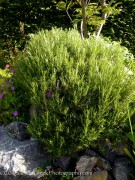
Discovered as a volunteer seedling in northern California, ‘Irene’s low mounding habit is much improved over older prostrate Rosemarys. Dense, gray-green, narrow leaves make a vigorous show on long, pendant branches, and the richly colored blue-violet flowers are larger and more profuse than those displayed by other trailing cultivars. Let it cascade down a wall or over the lip of an easily viewed terracotta vessel. Rosemary Irene (PP#9124)
Blooms January–April
Size: 12" – 2' 0" high x 4' 0" wide.
Hardy to zone 8.
Rosmarinus officinalis ‘Lady In White’ (S-0864)
Each $12.00
Scented, slim deep green leaves and closely set, erect branches host a lucent showing of exquisite 2-lipped pure white blooms. Harder to find than the typical blue-flowering cultivars, ‘Lady in White’ presents a compact low-growing habit that wields both beauty and brawn. Petite pearlescent blooms mesmerize the pollinators in the rockery or in a water-wise planting, while the winning foliage lends savory notes to focaccia and tomato dishes.
Blooms January–April
Size: 18" – 2' 0" high x 2' 0" – 3' 0" wide.
Zone 7b/8.
Dubbed for the renowned herbal enthusiast from Texas, ‘Madeline Hill’ is not only a good-looking tough cookie hardy to below 0°, but she’s a savory delight as well. Intensely fragrant, needle-style rich green leaves, which are broader than ‘Arp’s, cloak her robust, upright pale green stems. Forging a not-too-tall bushy guise, this well-branched Rosemary is generously sprinkled with engaging light blue flowers. Never fussy, she takes heat and poor soil, resists pests and deer and only improves with age. Good drainage is preferred.
Blooms January–April
Size: 3' 0" high x 3' 0" wide.
Hardy to zone 6.
Rosmarinus officinalis ‘Majorca Pink’ (S-0346)
Each $12.00
A welcome departure from the typical blue blossoms associated with the genus, this attractive upright Mediterranean denizen debuts lovely pastel lavender pink flowers amongst minute short needled gray-green leaves. Wafting crisp slightly fruity aromas, the trim loosely arranged foliage garnishes stiff steadfast branches and makes a stellar evergreen hedge for the herb garden or a water-thrifty planting, consorting with like-minded low maintenance companions such as Correa alba ‘Bronze Select’, Cistus ‘Natacha’ and Eriogonum ‘Little Rascal’.
Blooms January–May
Size: 3' 0" – 4' 0" high x 2' 0" wide.
Hardy to zone 8.
Rosmarinus officinalis ‘Maltese White’ (S-0480)
Each $12.00
We found ‘Maltese White’ at Bob Brown’s Cotswold Nursery in England, and presume this little known bushy Rosemary was discovered and named by some plantsperson traveling around the tiny Mediterranean island of Malta. Small, bright clusters of snowy white blooms decorate its silvery stems and resinous green-gray needles. A restful medley of color, these soothing hues will convey a courtly air to your Mediterranean border.
Blooms January–April.
Size: 3' 0" – 3-1/2' high x 2' 0" wide.
Hardy to zone 8.
A gift from our friend Jim Lockman, ‘Santa Barbara Blue’ seems to be known only in small gardening circles in California. Densely clustered needles lend a finely textured look to this upright evergreen with elegantly sweeping lower branches. The azure-blue flowers beautifully complement the concurrent blooms of Cistus ‘Red Eye’ and the deep green foliage contrasts strikingly with gray-leafed Teucrium fruticans (Select Form).
Blooms January–May.
Size: 5' 0" high x 4' 0" wide.
Hardy to zone 8.
Rosmarinus officinalis ‘Sawyer’s Blue’ (S-0699)
OUT OF PRODUCTION AT THIS TIME
Email me when this plant is available
Celebrated as an excellent choice for topiary, this tall standing Britishman has stiffly upright branches. Aromatic, narrow green leaves make a savory seasoning, while bright bluish purple flowers bring a little bit of the heavens down to earth.
Clipped into fanciful shapes, hedged or left au naturale, ‘Sawyer’s Blue’ melds with other water wise plants such as Teucriums, Carex glauca and Lavandula ‘Lullingstone Castle’.
Blooms January – April.
Size: 3' 0" – 4' 0" high x 3' 0" wide.
Zone 7/8.
Rosmarinus officinalis ‘Taylor’s Blue’ (S-0701)
OUT OF PRODUCTION AT THIS TIME
Email me when this plant is available

If you are short on space, consider this compact well-groomed Rosemary introduced by the late Ken Taylor. A no-fuss ‘Collingwood Ingram’ sport, the close-set, shiny deep green leaves on trailing and upward arching stems are loaded with bright lavender-blue blooms. ‘Taylor’s Blue’ can be tucked into a dry area where its dark, fine textured needles offset Cistus ‘Tania Compton’s rippled gray-green foliage.
Blooms January – April.
Size: 2' 0" high x 3' 0" wide.
Zone 7/8.
Salix
Willow
This diverse genus includes 300 deciduous species that are a breeze to grow in just about any garden soil. Our offerings emphasize intriguing stems, foliage and silhouettes.
Salix brachycarpa ‘Blue Fox’ (S-0844)
Each $13.00
Selected from a deciduous cold-hardy species native to the stream beds and sandbars of the Rocky Mountains, this fetching multistemmed cultivar is embellished with narrow, fine textured blue-green leaves, donning delicate, soft-looking hairs. The upright, smooth purple branches slowly wield a compact, rounded shrub that handles pruning and wet environs plus provides alluring winter color. Known to mitigate erosion and squeeze into tight spots, no-fuss ‘Blue Fox’ creates a stunning, low formal hedge when shorn and a small, shapely specimen in waterside venues, foundation plantings as well as moderately-moist mixed borders.
Size: 3' 0" – 4' 0" high x 3' 0" – 4' 0" wide.
Hardy to zone 3.
Salix integra ‘Hakuro Nishiki’ (S-0451)
Each $12.50
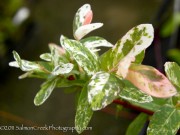
Young bright pink shoots plus the slender cream-dappled green leaves forge a dramatic counterpoint to white-streaked grayish green mature foliage. Interest persists as the year progresses: yellow foliar color heralds autumn, new polished bright red stems brighten a winter day, and early spring brings pendent yellow catkins. ‘Hakuro Nishiki’s graceful arching attributes deserve the spotlight a dark background affords. Somewhat more tolerant of occasional dry conditions than most Salix, Dappled Japanese Willow prospers in moderately moist soil and appreciates a late winter or early spring pruning to ensure its artful deciduous display.
Size: 4' 0" – 6' 0" high x 3' 0" – 5' 0" wide.
Hardy to zone 5.
Salix purpurea ‘Nana’ (S-0816)
Each $13.00
Handsome, thin bluish green leaves, showy light-colored catkins and supple slim purple stems, which are perfect for basket making, characterize this fast growing versatile Willow. Responsive to shearing, ‘Nana’s easily cultivated compact habit can be sculpted into a colorful topiary, refined-looking hedge or an artful bonsai specimen. In addition to its urbane ornamental merits, Dwarf Purple Osier furnishes nesting sites for small birds, attracts butterflies, aids erosion control and tackles moderate drought along with difficult low soggy sites.
Blooms April–May
Size: 3' 0" – 5' 0" high x 3' 0" – 5' 0" wide.
Hardy to zone 4.
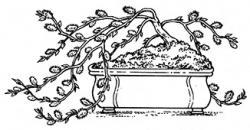
This small-sized ground-hugger greets spring with adorable fluffy cream-colored catkins on slender naked branches. The prostrate twigs and branchlets divide into thinner curved reddish stems, weaving a unique pendent drape of thin gray-green deciduous leaves that don silvered undersides. An easily cultivated, artful specimen for containers and rock gardens, ‘Boyd’s Pendula’ can cascade down stone walls, ramble along pathways or be featured as an exquisite bonsai specimen. Full sun ensures its vigor.
Blooms March–April
Size: 10" high x 2' 0" – 3' 0" wide.
Hardy to zone 5.
Sambucus
Elderberry
Throughout the world, Elders have long been considered powerful trees and shrubs. Sicilians thought the branches killed serpents and drove away robbers; Serbs believed the branches brought good luck at weddings; the English carried knotted twigs in their pockets to ward off rheumatism. We invite you to plant Elders to provide quick shade, wind protection, or an easy screen for unwanted views.
These wild-looking deciduous shrubs grow quickly and offer a beautiful accent near water. With pinnate leaves, white to pink flat flower clusters that measure up to 10 in. wide, and small, dark fruit, most of the twenty species of the genus like good, moist soil.
Sambucus canadensis ‘Aurea’ (S-0843)
Each $13.25
Indigenous to eastern North America, this attractive, multistemmed bushy shrub has many merits: foot-long, golden yellow foliage, myriad lemon-scented white panicles and small, bird-friendly cherry-red fruit. The showy summer display of large, luminous flat-headed blooms set against lambent, pinnately compound leaves, emphasizing 9 lance-shaped, deciduous leaflets, affords a glowing spectacle. Adored by butterflies plus a tasty ingredient in pies, jellies and wine, ‘Aurea’s robust suckering habit can be featured as a mixed border specimen, massed in naturalized areas, utilized as an informal hedge or planted near water. Good drainage, humus-rich soil, moderate moisture and regular pruning maintain a stylish rounded shape.
Blooms June–July
Size: 8' 0" high x 6' 0" wide.
Zone 3/4.
Each $16.75
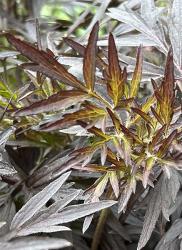
Awarded the Royal Boskoop Horticultural medal, this large reliable Elder is the classy outcome of an extensive 10 year British breeding program. Sumptuous purplish ebony shades infuse the young stems and fine-cut compound pinnate leaves that impart a lacy Japanese Maple flair. Garnished with broad lemon-scented pink umbels and edible blackish red berries, ‘Black Lace’s comely upright profile works best either as a fast-growing accent or massed as a mysterious deciduous backdrop for a natural-style border, where it entices gardeners, birds and other wildlife, fancies periodic pruning plus endures clay and deer. (pp#15,575)
Blooms June–July
Size: 6' 0" – 8' 0" high x 6' 0" – 8' 0" wide.
Hardy to zone 4.
Sambucus nigra ‘Gerda’ (S-0595)
OUT OF PRODUCTION AT THIS TIME
Email me when this plant is available
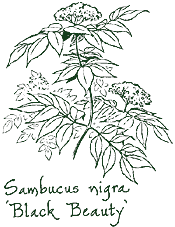
Sambucus nigra Black Beauty™
Set apart by its intense purple-black leaves, this Sambucus comes to us from a special breeding program in Kent, England. The passionate hue of the foliage remains all season, darkening as autumn approaches. Superbly displayed against the dramatic leaves, unique, deep pink, lemon-scented umbels develop to almost 10 in. across.
Partner this thoroughbred with the golden foliage of Spiraea ‘Ogon’ or let her stand as an alluring backdrop for the silvery inflorescences of the late blooming grasses. Minimal pruning will easily maintain ‘Black Beauty’s smaller silhouette for gardens short on space. (PP#12,305)
Blooms May–June.
Size: 10' 0" – 12' 0" high x 6' 0" – 8' 0" wide.
Hardy to zone 4.
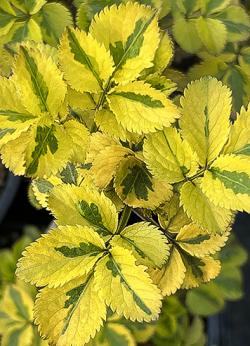
Touted as one of the choicest hardy variegated shrubs in cultivation, the snazzy deciduous foliage ranges from light green to chartreuse when young, and cream to gold or gray-green upon maturity. A slower growing resilient habit, stylish ivory-colored umbels and glossy black berries offer additional allure. Perfect for mixed borders and wilder venues, ‘Madonna’s eye-catching persona can be superimposed against dark-leafed Taxus ‘H. M. Eddie’, while enjoying a yearly pruning plus adequately moist sites with moderate fertility and good drainage.
Blooms late June–July
Size: 6' 0" – 8' 0" high x 6' 0" – 8' 0" wide.
Hardy to zone 5.
Sambucus racemosa ‘Sutherland Gold’ (S-0750)
OUT OF PRODUCTION AT THIS TIME
Email me when this plant is available
Springtime layers of finely dissected golden foliage attire this award-winning multistemmed Sambucus. More resistant to sun scorch than other yellow-leafed Elderberry cultivars, the delicate looking ferny leaves emerge in copper-hued shades and slowly develop a refreshing lime-green cast during the warmer months. Favoring judicious pruning, adequately moist soil and bright partial shade, its graceful visage is further enhanced by conical racemes of creamy white flowers and glossy red fruit that birds adore.
Blooms late April – May.
Size: 6' 0" – 10' 0" high x 6' 0" – 10' 0" wide.
Zone 3/4.
Santolina chamaecyparissus var. nana (S-0579)
Each $12.00
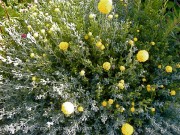
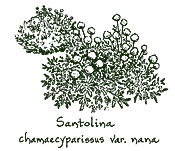
Botanicals first mentioned Santolina in 1550, when its dense filigree foliage and white-felted stems made it the star player of that Elizabethan rage, the formal knot garden. This dwarf cultivar stages countless golden-yellow button flowers on a tight evergreen mound of aromatic silver-gray. It’s deer and pest proof, extremely drought tolerant, and is still the perfect choice for edging the herb garden and tuck-ing into the rockery or a small sunny nook.
Blooms July–August
Size: 12" high x 12" wide.
Hardy to zone 6.
Sarcococca
Sweetbox
Sarcococca hookeriana ssp. var. humilis (S-0751)
Each $15.75

This tiptop Himalayan denizen lends evergreen finery and heavenly winter fragrance to a shady locale. Crafting a low, well-groomed textural ground cover, slowly creeping stolons sprout 18 in. stems clad in lustrous, narrow dark green leaves. Copious, tiny white flowers and round blue-black fruit heighten allure. Tailor-made for hedging, enhancing entrance ways or carpeting the woodland garden, Dwarf Sweetbox keeps deer at bay plus appreciates regular watering and an annual shearing to sustain its dashing appearance.
Blooms March–April
Size: 18" – 2' 0" high x 3' 0" – 4' 0" wide.
Hardy to zone 6.
Sarcococca hookeriana ‘Winter Gem’ (S-0880)
Each $15.75
Promoting its parent’s choicest qualities, this handsome Sarcococca humilis and Sarcococca hookeriana hybrid was masterminded by esteemed plant breeder Peter Moore from Hillier Nursery. Clustered cardinal-colored buds, prolific sweetly scented white blooms and spherical red berries are cozied amid close-knit low-lying stems with larger-than-average polished dark green leaves. An indispensable evergreen for the winter garden that abides shade and periodic dry soil, ‘Winter Gem’s resilient habit can be featured in containers, planted as a gleaming ground cover or clipped into a small easy-care hedge. (pp#26,599)
Blooms February–April
Size: 12" – 2' 0" high x 12" – 2' 0" wide.
Zone 6b/7.
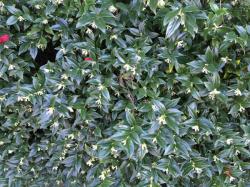
Nearly identical to it’s handsome cousin, Sarcococca humilis, save only for a larger stature, this natty Sweetbox’s compact quiet beauty delivers a wintertime delight when small tassel-like milk-white blooms waft a delectable vanilla scent. Graceful arching stems, densely cloaked in polished deer-resistant dark green leaves, are festooned with globular blood red berries, which eventually turn black and impart additional early season appeal. An 1887 discovery in central China by Scottish physician Augustine Henry, easy-care Sarcococca ruscifolia endures deep shade as well as somewhat dry soil and can be hedged, planted near a well-traveled pathway or trained upwards on a patio wall as an evergreen espalier.
Blooms February–early April
Size: 3' 0" – 4' 0" high x 3' 0" – 4' 0" wide.
Hardy to zone 7.
OUT OF PRODUCTION AT THIS TIME
Email me when this plant is available
Inciting a hubbub of horticultural intrigue because of its house plant affiliations, this bold tropicalthemed broadleaf evergreen is surprisingly hardy. Low-branching Schefflera delavayi launches wide umbrellas of lobed Oak-shaped new growth cloaked with an alluring fawn-colored fuzz and mature, glossy green compound leaves that can reach a massive 3 ft. across, while long lacy sprays distinguished by petite white flowers make a luminous autumn display. An Aralia family member indigenous to southeastern China and Vietnam's higher regions, the Umbrella Tree needs dappled shade and rich well-drained evenly moist soil to sustain its gallant good looks.
Blooms October.
Size: 10' 0" – 15' 0" high x 5' 0" – 8' 0" wide.
Hardy to zone 7.
OUT OF PRODUCTION AT THIS TIME
Email me when this plant is available
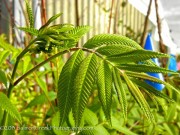
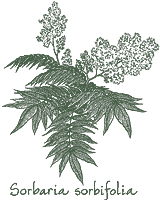
Ushering bold grandeur into the backdrop of a large shrubby planting or a woodland’s edge, this dramatic Spiraea cousin hails from eastern Asia. Stiff, thick suckering stems spawn tropical-looking, elegantly chiseled pinnate foliage with serrated and pleated deciduous leaflets beneath a creamy white explosion of giant Astilbe-like plumes. Tiny individual flowers feature cupped calyxes, prominent stamens and reflexed petals for starry appeal.
Reputed to contain valuable antioxidants, the lush growing Sorbaria sorbifolia favors rich, moist soil in cooler climates, while regular pruning and cane removal will keep its spreading nature curbed.
Blooms June–July.
Size: 5' 0" – 10' 0" high x 5' 0" – 10' 0" wide.
Hardy to zone 2.
Sorbaria sorbifolia ‘Sem’ (S-0856)
Each $12.00

Indigenous to Russia’s Ural Mountains as well as parts of Kazakhstan and Siberia, ‘Sem’s kin are familiar with harsh conditions. More compact and shorter than the species, this ultrahardy textural marvel unleashes dense suckering branches clothed in fern-like, pinnately compound leaves. Distinguished by springtime amber, pink and tangerine hues and bright green tones for summer, the delicate-looking serrated foliage hoists enormous Astilbe-style white panicles housing zillions of petite fleecy flowers. Ural False Spirea’s deciduous habit can grace slopes, mixed borders or foundation plantings, where it promises eye-catching foliar and floral allure plus enjoys regular water. (pp#16,336)
Blooms June–July
Size: 3' 0" – 4' 0" high x 4' 0" – 6' 0" wide.
Zone 2/3.
Spiraea

With attractive foliage and a graceful habit, these hardy, deciduous flowering shrubs belong to the Rose family, and are easily grown in any fertile, somewhat moisture-retentive garden soil.
Spiraea betulifolia ‘Tor’ (S-0753)
Each $13.75
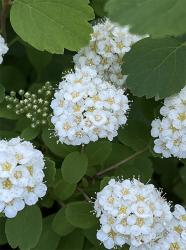
Unique among Spireas for its petite oval-shaped Birch-like leaves, ‘Tor’s tightknit orderly mounds make a reflective deep green foil for clustered purplish buds and a profusion of sprightly snow-white blooms that charm the butterflies. Autumn brings additional enticements when the refined foliage premieres orange, red and purple colors. Employed as a mixed border or rockery specimen, or planted en masse along pathways and foundations, this compact deciduous shrub fancies sunshine and periodic pruning. It combines well with silver-dappled Pulmonarias or Carex testacea, which provide compelling foliar contrast.
Blooms May–June
Size: 2' 0" – 3' 0" high x 2' 0" – 3' 0" wide.
Zone 3/4.
Spiraea betulifolia ‘Tor Gold’ (S-0896)
Each $13.75
A standout Spiraea ‘Tor’ sport discovered in the Netherlands, this fulgent 2008 introduction bears densely woven twigs lined with petite, lance-shaped and toothed leaves that emerge bright yellow, then turn chartreuse. Butterfly-friendly flat-topped clusters of tiny, 5-petaled white blooms unfurling from copious pink-blushed buds illuminate the trim rounded mound. Enriched by spectacular cardinal, tangerine and plum fall colors, easy-care ‘Tor Gold’ keeps a low-growing cold-hardy profile, whether hedged, massed in mixed borders and foundation plantings, or featured as a deciduous specimen in rockeries, cottage gardens and containers. (PPAF)
Blooms May–June
Size: 3' 0" – 4' 0" high x 3' 0" – 4' 0" wide.
Hardy to zone 4.
Spiraea japonica ‘Bullata’ (S-0817)
Each $13.75
An unsung heirloom hero that dates back to 1881, this diminutive darling deserves more attention. Close-knit twiggy growth clad in tiny crinkled dark green deciduous leaves sculpts a compact, yet broad tailored foundation with big clusters of lipstick pretty, deep rosy crimson flowers. Undemanding ‘Bullata’ is custom-made for patio containers, a rock garden or the front lines, either in a border or along a path.
Blooms June–July
Size: 16" – 2' 0" high x 20" – 2-1/2' wide.
Hardy to zone 4.
Spiraea thunbergii ‘Ogon’ (S-0572)
Each $13.75
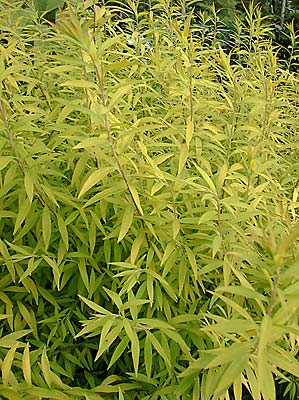
Among the first shrubs to bloom, ‘Ogon’s dainty, 5-petaled white flowers are arranged in abundant clusters along its wiry bare branches. Later, small and slender Willow-like foliage attires the numerous dark twigs. Illuminated in golden shades, this fine textured Japanese selection conveys a bright wispy presence in the midst of blue-flowering Geranium ‘Nimbus’, Ceanothus ‘Gloire de Versailles’ and Euphorbias.
Blooms March–April
Size: 4' 0" high x 4' 0" wide.
Hardy to zone 5.
This well-loved sturdy shrub has been delivering reliable spring flowers since 1868, when it was first introduced by the French shrub enthusiast and nurserymen Joseph Billard. Dense clustered umbels of tiny white blooms fashion a scintillating mantle that nearly conceals the copious gracefully arching branches. Spiraea x vanhouttei’s shapely medium-sized habit hosts small rhomboid-shaped green deciduous leaves with coarsely serrated margins and yellow or violet autumn hues. A cross between S. trilobata and S. cantoniensis, Bridalwreath makes an ideal low-maintenance addition to foundation plantings as well as sunny woodland margins and mixed borders, where it can be grouped or planted as a prominent specimen amid perennials and grasses.
Blooms April–May
Size: 5' 0" – 8' 0" high x 5' 0" – 8' 0" wide.
Zone 3/4.
A demure Japanese and Korean denizen, this dense low growing deciduous shrub imparts a quiet sophistication that belies its dogged constitution. Downward arching, slender, warm brown stems form an interlacing mound guised with crinkled, bright green Maple-like leaves and loose clusters of tiny star-shaped creamy white flowers. Effective for stabilizing banks and hillsides, and utilized as a fast spreading shrubby ground cover, low hedge, wall drape or foundation plant, ‘Crispa’ offers toasty soft orange and yellow shades in the fall, wards off deer and appreciates moist acidic soil plus judicious pruning, either in late winter or late spring.
Blooms May–June
Size: 12" – 2-1/2' high x 12" – 4' 0" wide.
Hardy to zone 4.
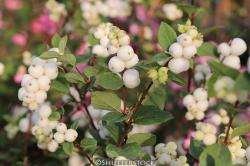
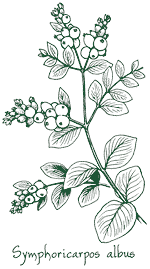
Favoring dry rocky haunts from Nova Scotia west to British Columbia, south to California then east to Virginia, this bushy native possesses a neat rounded appearance. Anchored by sturdy roots, the dense easily grown deciduous thicket produces hollow arching branches with opposite, serrated green leaves and a bounty of clustered small bell-style pink flowers at the leaf axils, mesmerizing both hummingbirds and butterflies. Globe-shaped decorative white berries persist on naked twigs throughout the winter and supply welcome food for birds and other wildlife, while various plant parts have been used medicinally to alleviate morning sickness, skin rashes and sore eyes. Tolerant of most soil types, including wet ones, Snowberry can be massed or naturalized, where it easily restores riparian habitats, abates erosion and spruces up your garden.
Blooms June–July
Size: 2-1/2' – 5' 0" high x 2-1/2' – 5' 0" wide.
Hardy to zone 3.
Syringa
Lilac
Few purple flowers have so inspired people as to lend their name to a particular tint: heliotrope, lavender, violet and of course lilac. With a charming flower display that bridges the gap between spring and summer, this deciduous genus includes some of the most sweet-scented, elegant and colorful woody plants available.
Each $16.75
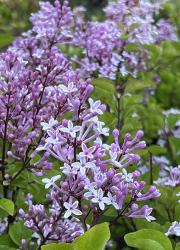
A stand-out among Lilacs, this sumptuous small-statured cultivar was introduced in 1976 by France’s internationally acclaimed Minier Nursery. Beguiling bees, butterflies and plant connoisseurs, dense wildly perfumed panicles of star-like lilac-pink blooms bestow a sensational spring showing and continue to unfurl sporadically throughout the summer amid broadly-ovate deciduous greenery. ‘Josée’s compact rounded habit makes an easy-care floriferous statement in cut arrangements, patio nooks and near garden benches or entranceways, where it tolerates heat and cold.
Blooms May–September
Size: 4' 0" – 6' 0" high x 4' 0" – 6' 0" wide.
Hardy to zone 3.
OUT OF PRODUCTION AT THIS TIME
Email me when this plant is available

Few purple blossoms have so inspired people to lend their name to a particular tint: heliotrope, lavender, violet, and of course, lilac. Distinguished by its uniquely shaped dark green leaves, this elegant Chinese native fashions a graceful mound of lacy, deeply cut foliage and 3 in. long, loose panicles of fragrant, single, pale lavender flowers.
Very heat tolerant, the Cut Leaf Lilac is perfect for hot summer areas and makes an excellent textural companion when teamed with broader leafed shrubs.
Blooms May
Size: 6' 0" – 8' 0" high x 6' 0" – 8' 0" wide.
Hardy to zone 4.
Syringa meyeri ‘Palibin’ (S-0467)
Each $16.75
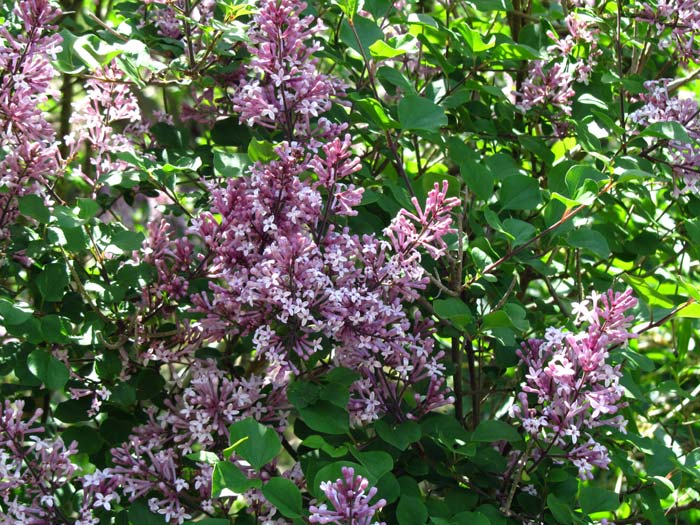
‘Palibin’s profusion of delicately perfumed lavender-pink blooms bursts forth from dark purple buds. Thick, polished deep green leaves envelope the close-knit twiggy shrub, whose small appealing profile makes a verdant hedge all season long, with or without pruning, or becomes an alluring component for the rockery or a mixed border. Perhaps the most dwarf of all Lilacs, this refined jewel should be planted in well-drained soil and cut back after its flowers are spent to ensure the following year’s bloom.
Blooms May
Size: 3' 0" – 5' 0" high x 4' 0" wide.
Zone 3/4.
Each $16.75
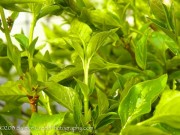
Few purple flowers have so inspired people as to lend their name to a particular tint: heliotrope, lavender, violet and of course lilac. With a charming floral display that bridges the gap between spring and summer, ‘Miss Kim’ flaunts a profusion of powerfully scented pinkish purple blooms that fade to light pink and then to white. Autumn finds the handsome foliage emblazoned by stunning shades of burgundy and red.
Plant in well drained soil and maintain a pleasing shape by pruning between December and February.
Blooms May
Size: 8' 0" – 10' 0" high x 4' 0" – 6' 0" wide.
Hardy to zone 3.
Syringa oblata var. dilitata ‘Betsy Ross’ (S-0717)
OUT OF PRODUCTION AT THIS TIME
Email me when this plant is available
Hats off to the late Dr. Donald Egolf, who bred ‘Betsy Ross’ using a Chinese specimen of S. oblata and an unidentified Lilac from New York. For its bountiful supply of fragrant, fluffy-looking, snow white trusses, thick dark green deciduous leaves and compact rounded frame, this National Arboretum introduction merits a prominent spot in your garden.
Brimming with old-fashioned charm, ‘Betsy Ross’ wards off mildew, endures warmer weather and flourishes in a vast range of climates, from Minnesota to the deep south and both east and west coasts.
Blooms April
Size: 8' 0" – 10' 0" high x 9' 0" – 11' 0" wide.
Zone 4/5.
Syringa vulgaris ‘Prairie Petite’ (S-0869)
Each $16.75
Hats off to the University of Nebraska for this prized diminutive Lilac whose beautiful blooms and tidy stalwart bearing make it indispensable in any landscape, especially those short on space. Garbed with attractive heart-shaped bright green leaves, the snug rounded habit hosts intensely fragrant 3 to 4 in. long pink panicles that eventually pale to lavender. Coveted by butterflies, honey bees and floral designers, ‘Prairie Petite’ can be clipped into a low hedge, ensconced in perennial borders and cottage gardens or planted along a foundation, while tolerating summer heat, cold winters and dry conditions.
Blooms May
Size: 3' 0" – 4' 0" high x 3' 0" – 4' 0" wide.
Zone 3/4.
Taxus
Yew
Arching, prostrate branches gracefully swoop down at the tips, sporting refined, soft-needled, saturated forest-green foliage. An uber-urbane landscape shrub, this short, tight set conifer is garnished with young, bright green shoots plus decorative small red berries that birds adore, but people and pets must not ingest. Applauded for its shade tolerance, tailored year-round aspect and superb response to pruning, pest-free ‘Repandens’ works well as a long-lived low hedge, medium-sized ground cover, or as a richly colored evergreen foil in mixed borders, woodland gardens and foundation plantings. Good drainage and protection from dry winter winds guarantee plush glossy growth.
Size: 2' 0" – 4' 0" high x 6' 0" – 8' 0" wide.
Hardy to zone 5.
Taxus media ‘Bonnie Green Mound’ (S-0663)
OUT OF PRODUCTION AT THIS TIME
Email me when this plant is available
Honored for their longevity since ancient times, Yews have always conveyed classic elements of design. Their amazing versatility affords an array of styles—topiaries, hedges or au natural—which easily enhances any garden scheme. Closely related to the popular Taxus ‘Densiformis’, this tidy verdant Taxus is distinguished by a fine texture, a compact rounded form becoming more dense with age, bright green needles and some drought tolerance once established.
We envision the evergreen Bonnie shaped into globes or bullets standing like sentinels, contrasted against silvery Teucriums or punctated amid boxwoods for a green-on-green textural contrast—all vignettes guaranteed to provide high drama.
Size: 3' 0" – 5' 0" high x 4' 0" wide.
Hardy to zone 4.
Taxus x media ‘Everlow’ (S-0891)
Each $15.00
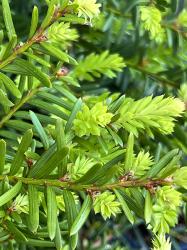
Parented by Taxus cuspidata and Taxus baccata, this hybrid evergreen’s signature is its suave slow-growing short visage that beckons year round. The glossy flattened dark forest green needles attire snug low-spreading branches, hosting perky light green spring growth as well as bird-beloved red berries. Tolerant of shade, wind burn, variable soil types, occasional dry periods, urban conditions and bunnies, ‘Everlow’s heroic good looks crave well-drained sites and can be massed or hedged plus clipped into a fanciful topiary or featured in a mixed border’s front row.
Size: 18" – 2' 0" high x 4' 0" – 5' 0" wide.
Hardy to zone 4.
Taxus x media ‘H. M. Eddie’ (S-0682)
Each $15.00
One of the most celebrated long-lived shrubs available for a classic evergreen hedge, this versatile interspecific hybrid promotes first-rate ornamental merit coupled with exceptional winter hardiness. Dense, slow-growing upright stems garbed in new bright green growth and mature, pointy forest-green needles distinguish the narrow columnar habit that affords lustrous, fine textured vertical accents. No-fuss ‘H. M. Eddie’ can be planted as a privacy screen, topiary specimen or mixed border stand-alone, where it abides shade, responds well to pruning and appreciates good drainage.
Size: 6' 0" – 8' 0" high x 3' 0" – 4' 0" wide.
Hardy to zone 5.
Teucrium
Germander
These evergreen shrubs and subshrubs are among the very toughest and therefore great for difficult situations; they thrive in heat and poor rocky soil. They also offer versatility, fitting into formal or informal designs with equal ease.
Each $12.25

Chamaedrys means “a gift on the ground,” and this Teucrium’s gifts include a compact form, small, shiny dark green leaves and spikes of pink flowers in the dog days of summer. It’s useful as a ground cover, edging or low hedge. Create your own knot garden by combining it with Barberry, Santolina and Boxwoods. A hard annual shearing will maintain a rich thicket.
Blooms June–August
Size: 18" high x 12" wide.
Zone 5/6.
A friend to the bees and butterflies, and once used to cure stomach ailments, droves of whorled, petite white blooms sparkle on short terminal panicles above varnished dark greenery. Small, rounded dentate leaves and low growing tight-set reddish stems distinguish this upright, delightfully aromatic subshrub. Second-to-none for the rockery, herb garden or a container, ‘Alba’s natty evergreen habit makes a no-fuss verdant minihedge, effectively corralling a boisterous bed.
Blooms June–early September
Size: 6" – 12" high x 8" – 15" wide.
Zone 5/6.
Teucrium fruticans (Select Form) (S-0156)
Each $13.00
-634.jpg)
Surprisingly light on its feet, this handsome ‘Select Form’ is smaller and more compact than Teucrium fruticans. Periwinkle-blue flowers embellish the downy white stems and gray-green, evergreen foliage which displays contrasting silver-gray undersides. Extremely durable, tolerating drought, wind and salt spray, this silvery mound makes an alluring backdrop for Muhlenbergia rigens.
Blooms January–July.
Size: 6' 0" high x 9' 0" wide.
Hardy to zone 8.
Teucrium fruticans ‘Azureum’ (S-0068)
Each $13.00

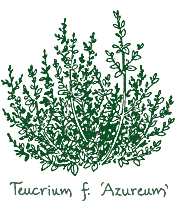
When you’ve got a trouble spot, ‘Azureum’ comes to the rescue. Half the size of Teucrium fruticans, and more of a shrubby ground cover, this vigorous, ruggedly charming cultivar bears eye catching lavender-blue flowers and evergreen foliage that’s gray-green above and silver-white beneath.
Blooms January–July.
Size: 3' 0" – 4' 0" high x 6' 0" wide.
Hardy to zone 8.
Ulmus
Elm
Ulmus parvifolia ‘Seiju’ (S-0728)
OUT OF PRODUCTION AT THIS TIME
Email me when this plant is available
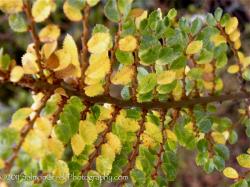

This dwarf Chinese Elm presents an array of ornamental attributes: fissured corklike bark, delicate branches uniquely arranged in somewhat flattened sprays, petite dark green foliage—elliptic, toothed and lustrous—and bright new growth. Unsurpassed in a trough, a rock garden or as a bonsai subject, it is a stellar, disease resistant sport of the ultraminiature Ulmus ‘Hokkaido’ with small reddish flowers, slightly larger deciduous leaves and a faster growth rate.
Bred by Carl Young of Lodi, California, ‘Seiju’s no-fuss nature loves sun and ample moisture, while abiding an array of soils.
Blooms August.
Size: 2' 0" – 10' 0" high x 2' 0" – 10' 0" wide.
Hardy to zone 4.
Viburnum
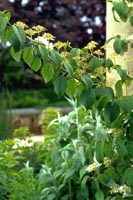
Our graceful Viburnum selections promise lovely spring blooms, winsome deciduous greenery and an enduring cold-hardiness. Preferring sun or part shade plus adequately-moist garden soil, these easily grown shrubs can be lodged in large containers and shrubby borders, or highlighted as stellar specimens and planted en masse.
Viburnum x burkwoodii ‘Anne Russell’ (S-0069)
OUT OF PRODUCTION AT THIS TIME
Email me when this plant is available
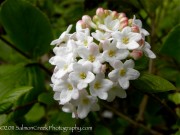
A 1957 recipient of the RHS Award of Merit, dense mounding ‘Anne Russell’ boasts pink buds and copious, domed 3 in. wide, waxy white flowers, which exude the most divine scent. Glossy dark green leaves end the season with luscious crimson-purple autumnal hues. This well-loved Viburnum can be ensconced near a patio, or utilized as an informal hedge or semideciduous specimen in a shrubby border. Be sure to indulge in her sweet scent.
Blooms April
Size: 6' 0" high x 8' 0" wide.
Hardy to zone 4.
Viburnum x burkwoodii ‘Conoy’ (S-0070)
OUT OF PRODUCTION AT THIS TIME
Email me when this plant is available
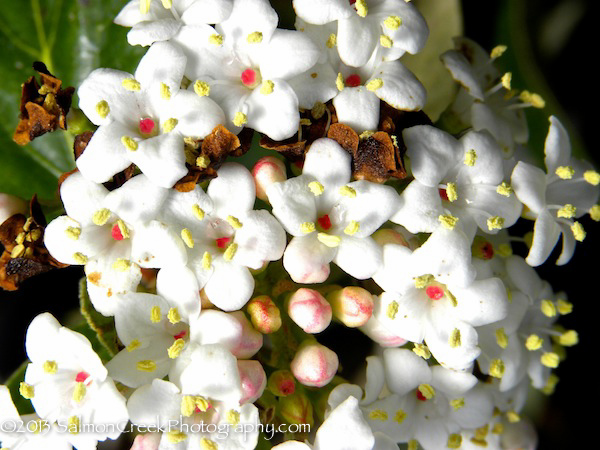
This evergreen Viburnum was the last, and possibly the finest, of Dr. Egolf’s introductions. Dark red buds open as creamy white to pink flowers amidst the most lustrous of all Viburnum foliage. Later, persistent glossy red fruit brightens the fine textured, deep green leaves, which are pale olive-green underneath and tinged with deep maroon in winter.
We are fond of this compact, colorful, low spreading shrub in containers, as a dense informal hedge, or in mass plantings.
Blooms late April.
Size: 4-1/2' high x 7' 0" wide.
Hardy to zone 6.
Viburnum x burkwoodii ‘Mohawk’ (S-0678)
OUT OF PRODUCTION AT THIS TIME
Email me when this plant is available
An ornamental prodigy from Dr. Donald Egolf’s esteemed breeding program, ‘Mohawk’s allure spans several seasons. Its first offering begins in spring when glistening dark red flower buds appear, followed by the spicy clove aroma of snowball-shaped blooms amid polished deep green deciduous foliage, and continues through its brilliant orange-red autumn finale. Anticipation builds as clustered buds wait a few weeks to open, revealing enticing, rouge-backed, waxy white flowers. Amenable to varied conditions, yet flourishing in moderately moist well-drained soil, this compact disease-resistant shrub can be cast as a star specimen, planted en masse or transformed into a picturesque backdrop.
Blooms late April–May
Size: 6' 0" – 8' 0" high x 6' 0" – 8' 0" wide.
Hardy to zone 5.
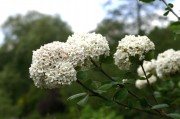
This much loved Japanese and Korean denizen has tantalized gardeners with its sweet vanilla-laden scent since 1906. First appearing in late autumn on naked light brown branches, the clustered red buds stir our interest as we eagerly await spring and the snowball-like 3 in. wide cymes of pink flowers, which mature to crisp white against broadly ovate dusty-green deciduous leaves. Aside from the fabulously fragrant blooms, the grand slow-growing Korean Spicebush offers plenty of reasons to invite it into your garden: red and black fruit (a beckoning sight for hungry birds), wine-red fall color, attractive smallish rounded frame plus a trouble-free low maintenance constitution.
Blooms March–April
Size: 4' 0" – 6' 0" high x 4' 0" – 6' 0" wide.
Hardy to zone 4.
Viburnum carlesii ‘Diana’ (S-0677)
OUT OF PRODUCTION AT THIS TIME
Email me when this plant is available
Some say her ambrosial fragrance can waft over 30 ft. away. We say you’ll want to plant this compact, medium-sized beauty as soon as possible. Tinged chocolate when young, the broadly ovate, serrated foliage matures to a dusty dark green with fuzzy gray-green undersides, and in fall broadcasts purple-red shades. Dome-shaped clusters of red buds herald the posh pink flowers which brighten to a satiny white, emitting the most irresistible Daphne-like perfume.
Mingling amid other broadleaf shrubs, positioned alone or employed as a hedge, the energetic deciduous ‘Diana’ should stay close to a well-traveled, moist sunny spot.
Blooms late March to mid-April.
Size: 5' 0" – 6' 0" high x 5' 0" wide.
Hardy to zone 4.
OUT OF PRODUCTION AT THIS TIME
Email me when this plant is available
Pink buds burst forth into waxy white blossoms as spring’s tender greenery attires this relatively tightset Egolf cultivar. Rounded flower heads feature bud and blossom simultaneously, creating a lovely two-toned effect. Lining the spreading branches, handsome, semisheened dark green foliage gives way to an orange-red hue in fall. A stellar stand-alone in the mixed border, ‘Cayuga’ claims Viburnum carlesii and Viburnum carlcephalum lineage, and adapts to an array of growing conditions.
Blooms late April.
Size: 5' 0" high x 6' 0" wide.
Hardy to zone 5.
Viburnum opulus ‘Smnvodr’ (S-0832)
OUT OF PRODUCTION AT THIS TIME
Email me when this plant is available
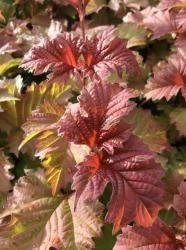
Vibrant color is the hallmark of this captivating newly introduced Viburnum. Embellished with exquisite, flat white lace-caps, the robust rounded habit spawns handsome deciduous 5-lobed maple-like leaves, which emerge a vivid red, age to lambent golden yellow, then flush dark tangerine and burgundy hues in autumn. Bunches of translucent scarlet berries keep the birds happy and our interest sparked. A versatile eye-catching specimen, Cranberry Bush thrives in any reasonable garden soil, enjoys protection from hot afternoon sun and exhibits superior cold hardiness.
Blooms May–June
Size: 6' 0" – 8' 0" high x 6' 0" – 8' 0" wide.
Hardy to zone 3.
Viburnum plicatum f. tomentosum ‘Molly Schroeder’ (S-0703)
OUT OF PRODUCTION AT THIS TIME
Email me when this plant is available
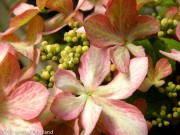
Headlining pretty pink, flat topped lacecaps poised on tiered horizontal branches, this sterling Viburnum selection from New Zealand promises a repeat autumn bloom and consistently pink flowers year after year unlike other cultivars that fade to white. Broad handsome deciduous foliage–dark green, prominently veined and purplish red come fall–cloaks her easy-going rounded frame. Full of rosy panache, ‘Molly Schroeder’ can be planted alongside Sambucus ‘Black Beauty’ and Physocarpus ‘Dart’s Gold’ with Epimedium ‘Amber Queen’ blanketing the ground below for a festive springtime vignette.
Blooms late April–May.
Size: 5' 0" – 8' 0" high x 5' 0" – 8' 0" wide.
Hardy to zone 5.
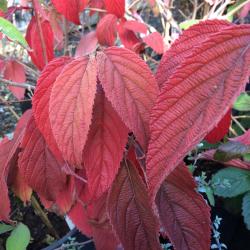
The most outstanding feature of this undemanding deciduous Viburnum is its horizontal growth habit, with flowers and fruit in parallel rows along the branches. ‘Shasta’ boasts deeply veined dark green foliage with a light fuzz on the underside, and glowing purple-red at summer’s end. Profuse, white flower clusters and shiny fruit abound in true Viburnum style.
Blooms April–May
Size: 6' 0" – 8' 0" high x 8' 0" – 10' 0" wide.
Hardy to zone 5.
Viburnum plicatum f. plicatum ‘Mary Milton’ (S-0620)
OUT OF PRODUCTION AT THIS TIME
Email me when this plant is available
Cushioned amid tiered branches and tailored forest green leaves, apple green buds herald a generous floral pageantry of luxe globe-shaped rose-pink blooms that often develop ivory and blush tones upon maturity. The broad pleated deciduous leaves lend textural accents, unfurling with bronzed-burgundy tones and flushing with plum and cardinal shades in autumn. Undemanding and quick to develop, this upright rounded shrub can be featured as a grand specimen beneath a tall, somewhat open canopy or grouped as an attractive backdrop for mixed borders and other plantings.
Blooms April–May
Size: 6' 0" – 8' 0" high x 6' 0" – 8' 0" wide.
Hardy to zone 5.
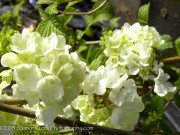
Heralding summer, this densely growing Viburnum displays sprightly round clusters of clean white flowers, borne in such profusion they nearly obscure the good-looking deciduous foliage. Autumn brings brilliant scarlet hues to the veined deep green leaves. Let Geranium ‘White Ness’ brighten its base while echoing ‘Popcorn’s greens and snowy whites.
Blooms June.
Size: 5' 0" – 6' 0" high x 5' 0" – 6' 0" wide.
Hardy to zone 5.
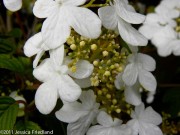
The most exceptional attribute of this deciduous Viburnum is its horizontal growth habit, featuring flowers and fruit in parallel rows along the branches. Distinguished by a smaller stature, and foliage that’s not quite as large as Viburnum ‘Shasta’, ‘Summer Snowflake’ maintains a more rounded form and blooms well into summer with an extravagant offering of pure white lacecap flowers. It’s lovely in containers, grouped in a drift, or as a star specimen.
Blooms April – August.
Size: 6' 0" high x 6' 0" wide.
Hardy to zone 5.
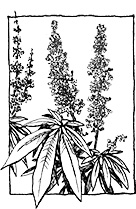
Though the species has been grown since the late 1500s, this medium-sized 2016 introduction touts a modern twist as enchanting pink flowers unfurl. Originating from the University of Georgia’s breeding program, ‘Pink Pinnacle’s well-endowed dense panicles furnish late summer enticements for both pollinators and gardeners amid handsome carefree greenery defined by 5 to 7 aromatic, short-stalked leaflets. The compact rounded foundation abides dry conditions, urban air pollution and a wide range of soil types. (pp#27,374)
Blooms August–September
Size: 6' 0" – 8' 0" high x 6' 0" – 8' 0" wide.
Hardy to zone 6.
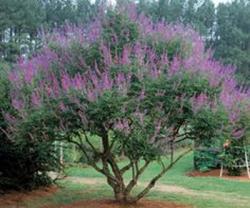
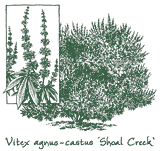
With cannabis-style palmate foliage and a virtuous history of helping both European monks and Demeter-devoted Greek women remain chaste, this woody Verbena relative is anything but modest. Late in the spring, young downy wood and numerous branching stems forge a broad swath clothed in 5-fingered, lance-like leaflets brightened by silver-felted undersides. Beat-the-heat colors distinguish the refreshing summer display as upright and spiky, nearly foot-long panicles of dense, lilac blue tubular flowers extend out from a stout rounded shrub or small tree. The aromatic, easy-to-grow Chaste Tree is a deciduous, sun-loving Mediterranean native whose stature depends on how severe the winters are or how far back its been trimmed. Enticing to hummingbirds and gardeners alike, it relishes well-drained soil and a hard cut in early spring, endures some drought once established and bestows a restful grace note to the mixed border.
Blooms August–September
Size: 8' 0" – 12' 0" high x 8' 0" – 12' 0" wide.
Hardy to zone 6.
Each $17.00
Beloved by hummingbirds, butterflies and gardeners alike, the lushly-colored burst of clustered funnel-like reddish magenta blooms showcases sunny-yellow throats plus a light fragrance. Glistening, elliptic to obovate-shaped dark greenery garnishes this diminutive old-fashioned deciduous shrub that develops an attractive compact rounded habit imbued with alluring cozy bronzy-purple shades. Tackling most foliar diseases, cold winters and clay soil, ‘Minuet’s undemanding mien lends prismatic accents to foundations, mixed borders, massed plantings or hedges.
Blooms May–June
Size: 2' 0" – 3' 0" high x 3' 0" – 4' 0" wide.
Hardy to zone 4.
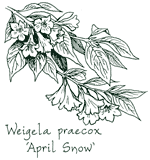
Originating from seed collected in northern China’s Wutai Shan mountains by Bluebird nursery owner, Harlan Hamernik, this seldom offered fragrant Weigela flaunts a snowy avalanche of clustered pure white tubular blossoms. The graceful pendent spring flowers illuminate pointed medium green glabrous leaves plus entrance hummingbirds and other garden visitors. Tidy, undemanding and well-mannered, aptly named ‘April Snow’ is ideal for mixed borders, foundation plantings and deciduous summer-time screens. (pp#20,006)
Blooms April–May
Size: 6' 0" high x 4' 0" – 6' 0" wide.
Hardy to zone 4.
The ‘wine’ is the glossy burgundy and purple foliage highlighted by lime-green midribs. The abundant ‘roses’ are red in bud, eventually becoming pink beauties that provide a stunning contrast to the leaves, and are great in cut arrangements. This truly superior cultivar holds its exquisite leaf color when other species will not, the rich shade intensifying as autumn approaches. (pp#10,772)
Blooms May–June
Size: 4' 0" – 5' 0" high x 4' 0" wide.
Hardy to zone 5.
Westringia
Coast Rosemary
Westringia fruticosa ‘Smokey’ (S-0664)
OUT OF PRODUCTION AT THIS TIME
Email me when this plant is available
With soft silvery shades and a fine texture, this rugged Australian native has a smoky allure. Petite evergreen leaves—narrow, pointed and emargined in cream—crowd a well-mannered, low growing twiggy frame. Just right for a hedge that’s not so tall, ‘Smokey’s compact habit naturally sculpts a perfect globe, withstanding drought once established, and seaside conditions.
Let the versatile Coast Rosemary settle in amongst dry-loving companions such as Cistus, Lavandula, grasses, and Salvia ‘Aromas’, and enjoy the subtle charm of its two lipped white flowers nearly all year round.
Blooms May–November
Size: 4' 0" – 6' 0" high x 4' 0" – 5' 0" wide.
Hardy to zone 8.
Xanthoceras sorbifolium (S-0721)
OUT OF PRODUCTION AT THIS TIME
Email me when this plant is available
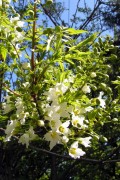

A hardy and versatile deciduous member of a mostly tropical family, this choice northern Chinese native headlines shiny, deep green pinnate leaves, defined by 9 to 17 serrated leaflets and lovely, white cupped flowers held in large Horse Chestnut-style clusters. A saffron-colored eye deepening to carmine-pink inscribes each sweetly scented, 5-petaled blossom. Come autumn, oval-shaped leathery capsules produce numerous, edible, large black seeds that supposedly taste like macadamia nuts.
Preferring a warm sunny locale, but also abiding a moist shady one, Yellowhorn’s upright and lacy silhouette possesses exceptional drought tolerance.
Blooms May.
Size: 12' 0" – 18' 0" high x 8' 0" – 10' 0" wide.
Hardy to zone 4.










